#North-Central San Juan Mountains
Explore tagged Tumblr posts
Photo

Report generated at 2024-11-20 15:09:32.942752-08:00 using satellite imagery and alert data provided by the National Weather Service.
Wind Advisory
Northeast Foothills/Sacramento Valley
Northern Lake County
Sonoma Coastal Range
Central Sacramento Valley
North Bay Interior Valleys
North Bay Interior Mountains
Mineral and Southern Lyon Counties
Mendocino Coast
Greater Reno-Carson City-Minden Area
Marin Coastal Range
Foothills of the Northern Blue Mountains of Oregon
Northern Sacramento Valley
Southern Lake County
Coastal North Bay Including Point Reyes National Seashore
San Francisco Bay Shoreline
Mono
San Francisco Peninsula Coast
San Francisco
Flood Watch
WA: Mason
Northern Lake County
Northwestern Mendocino Interior
Central Sacramento Valley
North Bay Interior Valleys
Del Norte Interior
Mountains Southwestern Shasta County to Western Colusa County
Shasta Lake Area / Northern Shasta County
Southern Trinity
Coastal Del Norte
Northeast Foothills/Sacramento Valley
Southwestern Mendocino Interior
Northern Humboldt Interior
North Bay Interior Mountains
Southwestern Humboldt
Sonoma Coastal Range
Southeastern Mendocino Interior
South Central Oregon Coast
Southern Lake County
Coastal North Bay Including Point Reyes National Seashore
Northern Humboldt Coast
Southern Humboldt Interior
Northeastern Mendocino Interior
Mendocino Coast
Marin Coastal Range
Northern Sacramento Valley
Winter Storm Warning
Sun Valley Region
Burney Basin / Eastern Shasta County
Western Siskiyou County
Western Plumas County/Lassen Park
North Central and Southeast Siskiyou County
West Slope Northern Sierra Nevada
Mountains Southwestern Shasta County to Western Colusa County
Sawtooth/Stanley Basin
South Central Siskiyou County
Shasta Lake Area / Northern Shasta County
Big Lost Highlands/Copper Basin
Okanogan Highlands
Northern Trinity
Northern and Eastern Klamath County and Western Lake County
Central Siskiyou County
South Central Oregon Cascades
Siskiyou Mountains and Southern Oregon Cascades
Winter Weather Advisory
North Oregon Cascades
Northern and Eastern Klamath County and Western Lake County
Central Panhandle Mountains
Northern Panhandle
Cascades of Lane County
Klamath Basin
East Slopes of the Oregon Cascades
West Central Mountains
Boise Mountains
Cascades of Marion and Linn Counties
West Slopes North Cascades and Passes
Northeast Mountains
Modoc County
Lassen-Eastern Plumas-Eastern Sierra Counties
High Wind Watch
Coastal Del Norte
Southern Humboldt Interior
Northern Humboldt Interior
Del Norte Interior
South Central Oregon Coast
Curry County Coast
Northern Humboldt Coast
Southwestern Humboldt
Flood Advisory
CA: Sierra, Lassen, Sonoma, Napa, Plumas
High Wind Warning
Central and Eastern Lake County
Northeast Siskiyou and Northwest Modoc Counties
Klamath Basin
Northern and Eastern Klamath County and Western Lake County
Central Siskiyou County
Modoc County
High Surf Advisory
Tillamook County Coast
San Luis Obispo County Beaches
Central Coast of Oregon
South Washington Coast
Santa Barbara County Central Coast Beaches
Central Coast
Clatsop County Coast
Coastal North Bay Including Point Reyes National Seashore
San Francisco Peninsula Coast
North Coast
San Francisco
Southern Monterey Bay and Big Sur Coast
Beach Hazards Statement
Northern Monterey Bay
Flood Warning
CA: Siskiyou
OR: Curry, Coos, Josephine, Jackson
Coastal Flood Advisory
Western Whatcom County
San Juan County
Lake Wind Advisory
Greater Lake Tahoe Area
Red Flag Warning
Lahontan Basin - Churchill and Eastern Mineral Counties
Southern Mono County
Southern Sierra Front - Alpine/Northern Mono/Southern Lyon/Western Mineral Counties
West Humboldt Basin - Pershing County
Northern Sierra Front - Carson City/Douglas/Storey/Southern Washoe/Eastern Lyon/Far Southern Lassen Counties
High Surf Warning
South Central Oregon Coast
Curry County Coast
Avalanche Warning
South Central Siskiyou County
5 notes
·
View notes
Photo
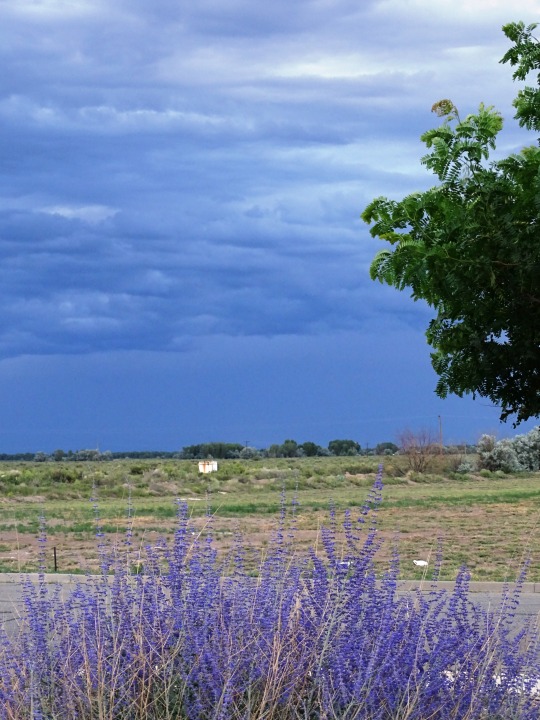

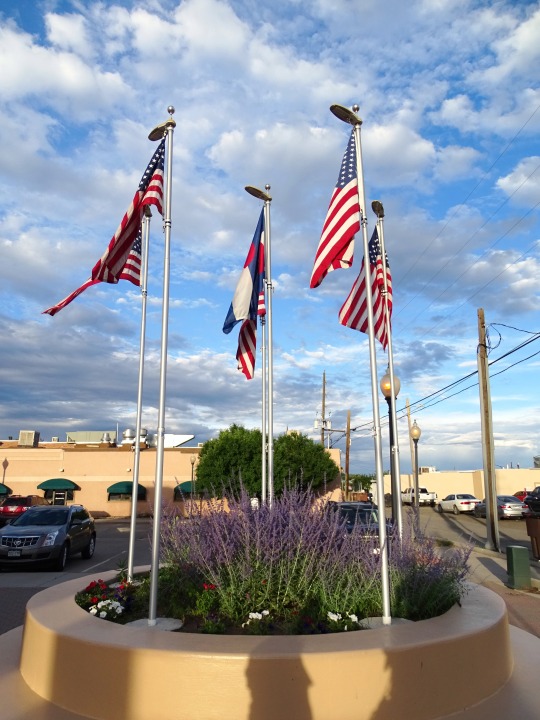
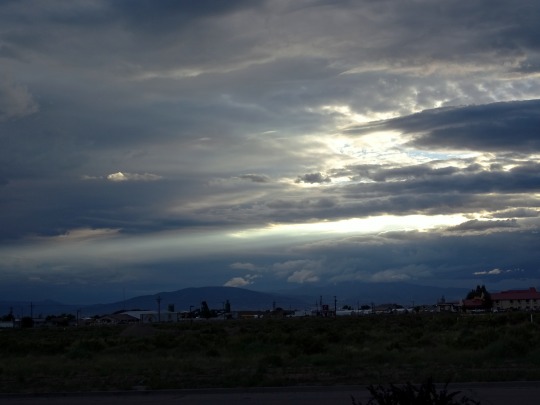

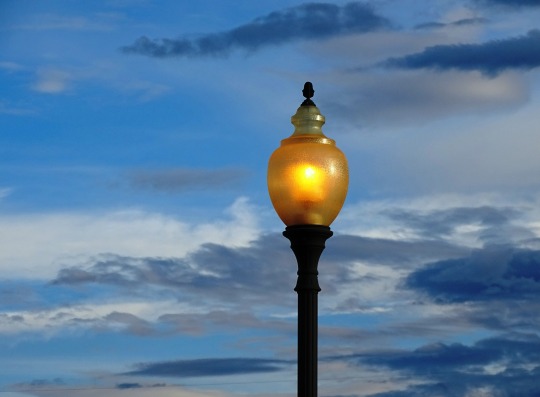
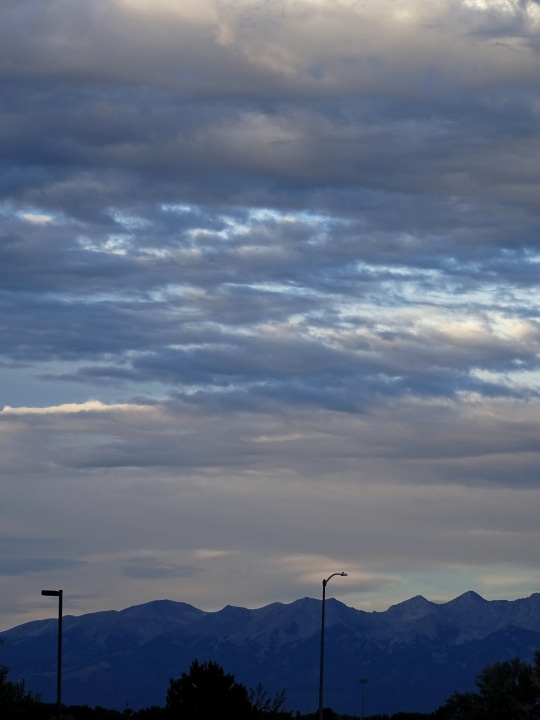


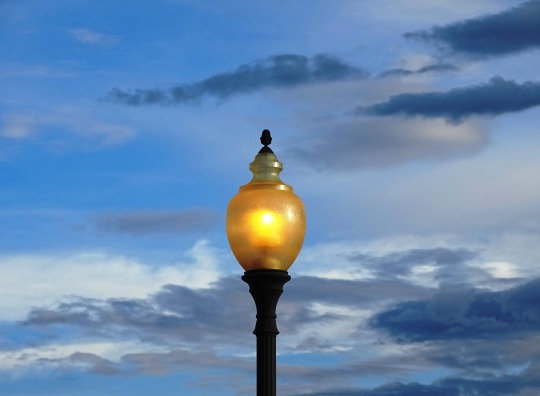
Alamosa, CO (No. 4)
The San Luis Valley was ceded to the United States by Mexico following the Mexican–American War. Hispanic settlers began moving north and settling in the valley after the United States made a treaty with the Utes and established a fort in the early 1850s. Prior to the Mexican war the Spanish and Mexican governments had reserved the valley to the Utes. Later in the 19th century Anglo settlers began to settle in the valley and engaged in mining, ranching, and irrigated agriculture. Today the valley has a diverse Anglo and Hispanic population.
The San Luis Valley is the broad, generally flat, valley at the headwaters of the Rio Grande in south central Colorado and far north central New Mexico. The northern portion of the San Luis Valley is an endorheic basin; surface water does not exit this area. Irrigated agriculture is possible in the area due to groundwater and streams fed by the average 100 inches of snow the surrounding mountain ranges receive. The southern portion is drained by the Rio Grande.
There is no clear southern boundary but the term is generally used to include the San Luis Hills of southern Colorado and the Taos Plateau of northern New Mexico. About 50 miles from east to west and about 150 miles from north to south, the valley is bounded on the east by the Sangre de Cristo Mountains and on the west by the San Juan Mountains.
Source: Wikipedia
#San Luis Valley#Centennial Plaza#US flag#street lamp#street light#USA#evening sky#dark clouds#original photography#downtown#vacation#tourist attraction#landmark#lavender#San Juan Mountains#summer 2022#Rocky Mountains#Colorado#landscape#countryside#I really love the first pic#architecture#small town#Alamosa
8 notes
·
View notes
Text

The all-new 2024 Toyota Land Cruiser is the perfect partner for an adventure through South-Central Colorado
Explore The Vast Wilderness of South-Central Colorado’s Rugged Backcountry
National Geographic Photographer Keith Ladzinski goes off-grid in the Centennial State to Rediscover this unique region.
— Photographs By Keith Ladzinski | June 3, 2024
Soaring peaks, sprawling sand dunes, and small ranch towns define the region of south-central Colorado and the San Luis Valley—one of the world’s largest alpine valleys—making it a natural launchpad for outdoor adventures like off-roading, backpacking, rock climbing, and backcountry hiking. The valley's beauty and nature also make it an ideal location for photographers looking for an off-the-beaten-path experience.
Colorad-raised National Geographic Photographer Keith Ladzinski was looking for just that. While his work documenting natural history and adventure sports takes him to the farthest reaches of the world, he loves getting back to his roots to uncover something new in unexpected places. For this assignment, he embarked on a trip from northern Colorado to the San Luis Valley to seek out rich culture, outdoor recreation, and the thrill of the open road.
I find a new nook, a new cranny. Every time I go down there, I discover a new piece of the San Luis Valley. This is a great place for a road trip with adventure along the way. You can rock climb, hike 14,000-foot peaks, ride horses, mountain bike, and find a lot of history. — Keith Ladzinski, National Geographic Photographer
In order to get out in the backcountry, travelers and photographers should be prepared to bring along all the tools needed, such as a GPS for when there is no cell service, camera equipment with a myriad of lenses, and the right vehicle—like the all-new 2024 Toyota Land Cruiser—which will not only take you on your off-road adventures but will also get you back.

Whether driving the dirt roads through the San Luis Valley or exploring the many small towns in the region, a vehicle like the all-new 2024 Toyota Land Cruiser can amplify the experience with full-time 4WD and trail-ready tech.
The San Luis Valley encompasses 8,000 square miles spread across six counties bordered by jagged mountains. To the east are the Sangre de Cristo Mountains, named in 1719 by a Spanish explorer. To the west are the San Juans, and to the north are the Saguache Mountains. These mountains surround one of the world’s largest high desert valleys at 8,100 feet. The San Luis Valley hosts nearly a dozen “Fourteeners” (14,000-foot mountain peaks) to climb, including Blanca Peak (14,350 feet), the fourth highest in the state, and Culebra Peak (14,047 feet), the highest in the Culebra Range, making it an ideal location for climbers and other adventure-seekers. The area also boasts numerous small-but-hardy towns, like Alamosa and Del Norte. These towns provide a snapshot of the region’s culture, as well as a window into its past.



The 8,000-square-mile San Luis Valley is home to a variety of flora and fauna, including wild horses and juniper trees, that survive in sometimes harsh conditions: a testament to the incredible life that can be found in south-central Colorado.
One of the area’s most breathtaking sights is the Great Sand Dunes National Park and Preserve, where the tallest dunes in North America showcase Sahara-like sands between alpine lakes, grasslands, wetlands, and forests. Visitors can hike and "surf" or sled down miles of dunes while carving out their own trails of the 30-square-mile active dunefield. Hidden Dune and Star Dune are tied for the tallest dunes in North America at 741 feet from base to peak. At night, the Milky Way and a plethora of constellations light up this certified International Dark Sky Park.
While the darkness is a draw for stargazers, the sunrises and sunsets in this region offer unique ambient lighting for photographers. At sunset, the Sangre de Cristo Mountains turn the iconic blood-red hue that gives them their name (“Blood of Christ”). But Ladzinski found beautiful lighting in less obvious places on his recent assignment. Trinchera Ranch, where Ladzinski spent several days, protects over 172,000 acres of protected landscape that includes not only extensive wildlife habitat, but opportunities for a range of outdoor activities. Thanks to the ranch’s conservation efforts, the pristine area features rivers, streams, aspen and conifer forests, and a myriad of hidden spots to photograph.


The Sangre de Cristo Mountains are illuminated at sunset.
Some of Ladzinski's most memorable moments involved finding perfectly illuminated landscapes. One early morning, he hiked out around Trinchera Ranch to capture a waterfall with a long exposure because he liked its structure and clean cascades.
“As someone who loves to shoot landscapes, a scene like that is so inviting,” he said. “It was right as the sky started to take on a different color. That compositional opportunity allowed me to riff less, look more.”


The incredible sunrises and sunsets in the San Luis Valley allowed Ladzinski to find the perfect light for capturing this waterfall (Top) and cottonwood trees (Bottom).
Another photo that demanded to be captured: leafless cottonwood trees at twilight, as the sky transitioned from yellow to purple. Ladzinski spent 20 minutes walking beneath a cottonwood grove admiring the twisting structures of leaves and branches.
“I love photographing trees," he said. "It was quite a special moment to me.”
Beyond the incredible landscapes beckoning adventure, there are also vast regions of preserved land for wildlife. The San Luis Valley National Wildlife Refuge Complex comprises the 12,000-acre Alamosa National Wildlife Refuge, the 15,000-acre Monte Vista National Wildlife Refuge, and the 93,000-acre Baca National Wildlife Refuge, each geographically diverse. Over 20,000 migrating sandhill cranes descend into the San Luis Valley from February to March yearly, then again from September through November. Sandhill cranes are just one of the hundreds of bird species enjoying the various wetlands, riparian corridors, grasslands, and rolling uplands of the San Luis Valley National Wildlife Refuge Complex and the Great Sand Dunes National Park, but thanks to their size and majestic manner, they’re a favorite sight among visitors.

Sandhill cranes are an incredible part of the area's diversity and spend part of each spring and fall in this valley.
The sandhill crane migration is mostly associated with Nebraska and those areas of the country, but you get a small piece of it that comes through the San Luis Valley. It’s unique in that you’re not looking at prairie and wetland. You’re looking at 14,000-foot mountains with birds coming into tiny wetlands. From that perspective, you get a mash-up of different pieces of Colorado. — Keith Ladzinski, National Geographic Photographer
Exploring these impressive landmarks requires a vehicle with grit and the ability to conquer rugged terrain. A vehicle like the all-new 2024 Toyota Land Cruiser is an ideal partner for exploration ahead.
There is no shortage of epic adventures and unique experiences in the San Luis Valley and south-central Colorado. From driving through juniper-wooded forests with alpine vibes and mountain views to exploring pastures and wetlands filled with wildlife, this region just might be the perfect place to reconnect with nature—and yourself.
#The Vast Wilderness#Rugged Backcountry#South-Central Colorado#Exploration#Centennial State | Rediscover | unique region
0 notes
Text
A Whole New Chapter
Road Trip!
Here we go, off on a 2-week road trip through Northern Luzon!
Days 1-2, La Union
Picked up at 7:00am by our driver, Artemio, we packed up and headed north out of Manila. Even at this time, on a Sunday morning, it took most of an hour to clear Manila. Partly due to 24/7 traffic, but even without traffic the Metro Manila area is really big, on par with the largest cities in the world, even Los Angeles. Going thru Manila, I was reminded what a country of economic contrast this is, with the gleaming high-rise buildings of Manila and Makati in the background of expansive squatters slums along the expressway.
North of Manila you quickly get into lush farm and ranch lands, no difference between the two really, as farmers growing sugar cane, corn, all sorts of vegetable crops, and of course, rice, will also have cattle and goats tied up here and there. I think they rotate sections of their land, with some growing crops, while others are being naturally cleared and fertilized. The land from north of Metro Manila all the way until you reach the sea south of La Union, stretching some 200 km, struck me as a green Central Valley (California), with endless farmlands bordered by mountains both east and west, with small towns and scattered industrial buildings. Not much need for canals and irrigation here, though the rice paddies must have some sort of canal-based or pumped irrigation as they need to be flooded. Here and there we saw a farmer tilling his field with a plow drawn by a Carabao, the native oxen used as a draft animal.
The useful Carabao (picture from an earlier visit):

I realized that one thing you don’t see much of here, as compared to the Central Valley or any farming region in the US, is farm equipment. There is an occasional small farm tractor, but most of the heavy work here is still born by animals, or just human labor.
Max agreed with us that it’s pretty nice to have a driver and just relax and enjoy the ride.

Max was excited to see all the moo-moo cows, his favorite animal! It’s taken him a while to recognize the Philippine cattle as moo-moo cows, as they look different and, especially around our home in Batangas, very skinny compared to US cows. I’ve always thought that the cattle here were Brahma, as they have humps and floppy ears like the ones I’ve seen in pictures from India. Researching it, I found that the local cattle are recognized as a separate breed, known simply as “Philippine Native” cattle, and are descended from cattle introduced from China and Mexico.

Continuing north, we passed through the city of Angeles, where some readers may have been stationed, or at least passed through, as it was the home of Clark AFB until 1991. Now the air base is the major international airport serving northern Luzon.
We stayed on the expressway until it ends in the town of Rosario where we turned west onto the Mac Arthur Highway.
After 5 ½ hours on the road, we reached our destination, San Juan, La Union (oo-nee-own). La Union has relatively recently grown up as a resort area and surfing hub of the Philippines. It’s one of two areas in the Philippines, the other being Siargao, that host a professional World Surfing League event (see “Mark and Georgia’s March 2019 Philippines Trip”, Days 13-15). And sure enough, in contrast to the calm waters we see in most of the Philippines, they got waves! Just like Hawaii, the biggest waves come in the winter, though these were enough to scare Max from the water. Our hotel was on a wide, quiet beach, with just a few surfers practicing on the waves.

We had Artemio drop us off in the next town down the coast, San Fernando, for dinner. San Fernando is the home of Urbiztondo beach, the center of the surfing scene. All along the beach are bars and restaurants, making this also party central! This seems to be what most of the generally younger crowd come to La Union for, the action on the beach rather than in the water.
Mass of humanity at Urbiztondo beach, a big contrast to the quiet beach where we’re staying!

We found a good Japanese restaurant just off the beach, that welcomed Max, and proceeded to eat too much…
An aside, regarding Max’s acceptance as a service animal over here, it’s a mixed bag, just as we’d read about before coming. Some places, restaurants, shops, hotels, etc., simply welcome him without any fuss at all. Some initially try to forbid him but give in when we show his registration card and a copy of a Philippines Senate bill that reads very much like the US ADA laws, which guarantee that a service animal has the same right of entry to any establishment that the animal’s owner/handler has. Some places, however, are just rude and don’t care what we show them. Lastly, some are actually knowledgeable that the Senate bill we are armed with has not yet passed the Senate and therefore not actually law in the Philippines. We don’t really push the issue much, and sometimes just move on.
After another full day sightseeing in and around La Union, we move on to Vigan, about a 3-hour drive up the coast.
Days 3-5, Vigan
Shortly after leaving San Juan, we enter the province of Ilocos Sur (Southern Ilocos). Provinces in the Philippines are like states in the U.S., with a Governor, legislature, and courts, the ability to create provincial laws, collect taxes, etc., while still operating under federal laws to an extent similar to the U.S. We live in Batangas province, La Union is another province, etc. There are 82 provinces in the Philippines.
We continue north on the Mac Arthur highway, a smooth, modern highway passing still through rich farm/ranch lands bordered by the sea to the west and mountains east. We pass through numerous small towns, many having familiar names such as Santa Cruz, Santa Maria, San Antonio, even San Jose and San Francisco, reflecting the influence of Spanish colonization.
Vigan has been on my “must visit” list for many years; it’s known as the foremost cultural heritage site in the Philippines. Having escaped most of the ravages of WW2 and other conflicts, the center of town retains the cobblestone streets and architecture from the Spanish colonial era (1565-1898).
It’s a short walk from our hotel to the nearby Calle Crisologo, the main “old town” street which is closed to auto traffic. We head that way, stopping for a quick lunch at nearby Plaza Burgos of local dishes including empanadas, okoy (veggie and seafood fritter), pinakbet (veggies and pork), dinakdakan (pork simmered in onions), and rice (all costing a whopping $4…). Getting to the Calle Crisologo, Georgia decided that Max and I needed a calesa ride. Calesa are the historic taxis of the Philippines, two-wheeled carriages drawn by small Philippine ponies. In every city at one time, they are still found giving rides to tourists, especially in places like Vigan. We walked along and selected a friendly looking pony, found that it cost only 200 pesos (about $3.50) for a 1-hour tour, so I hoisted Max up and off the three of us went on a nice tour of Vigan city.

One place we passed by that I was curious about was the Ilocos Sur Capitol building, which was sporting what appeared to be Pride flags and colors. Curious, because being LGBTQ+ is still illegal in the Philippines, though such laws are not enforced as far as I know, and like any place you see people here just openly being who they are. I was just surprised, though, in this strictly Catholic nation, to see a government entity in such apparent solidarity. On checking, I found that on July 1, 2023, the province of Ilocos Sur adopted a resolution to “Transcend in all Colors”, outlining a 10-point agenda to promote “Diversity, Equality, and Inclusivity”. Good for Ilocos Sur, hopefully such thinking will continue to spread throughout the Philippines.

On the good advice of our calesa driver, we went back to the hotel room to wait out the heat of the day, then returned to Calle Crisologo in the evening when it had cooled off. We enjoyed a walk down the street with its cobblestones and colonial era homes, many now converted to souvenir shops and restaurants.


We stopped at a streetside café for dinner and enjoyed a number of Ilocano dishes. Georgia explains that many dishes, e.g., Pinakbet, are found throughout the Philippines, but local variations can make large differences. For instance, I haven’t really enjoyed Pinakbet before, but tonight’s version was really good! Also, the longganisa (pork sausage) here is savory and garlicky vs. the sweet sausages by the same name found in most other regions.
The next morning we toured around town, going to a number of spots including one called the “Hidden Gardens”. Hidden, by being in an unexpected place within what looked like a residential area, it was a cool and serene path though a large garden. No admission fee, but there were ample opportunities to support the garden, and we did buy some plants to take home, to surprise our gardener Vima.
Monkeys 1, Max 0
I wish I had a video of this… In the parking lot of the garden there was a monkey in a small cage. Max was off leash, and we encouraged him to go have a look, and he cautiously moved towards the monkey. Then, suddenly, the monkey got mad, reared up with arms in the air, bared his teeth, and made a loud screech! In a millisecond Max was gone, running faster than I’d ever seen him go, even when he's trying to run down a Chuckit ball with his sister Lizzie! We had no idea at first where he went, but we found he’d taken refuge in the souvenir shop next to the parking lot. We’d planned that our next stop would be a local zoo but decided that one monkey would be enough for Max today!
So on to lunch. Empandas are an Ilocano specialty, so we went for another recommended empanaderia close to the hotel. Empanada are actually a common snack food all over the Philippines. Georgia makes them, based on her Mom’s recipe, with a meat and potato filling, sometimes with raisins for sweetness, baked in a folded pie crust shell. They are very different here – deep fried, have a lighter and crispy shell more like a spring roll wrapper, filled with shredded cabbage or green papaya, longganisa, and a whole egg. Different and delicious! All in all we tried 3 empanaderias, the last using shredded papaya rather than cabbage. We both agreed that this last one had the best flavor!
Crispy shell, cabbage, egg, and longganisa. Yum!

After lunch Artemio drove us down to Santa Maria, to see an old church which was designated as a UNESCO World Heritage site in 1993. The first church was established on this site in 1567, with construction on the present church beginning in 1765. This beautiful church has been well cared for, and of course escaped damage during the war.


All for now, just some of the sights and treats from La Union and Vigan. Next stops, Laoag and Pagudpud, Ilocos Norte, and Santa Ana, Cagayan.
Take care, see you soon!
1 note
·
View note
Video
Ponds and a Grassy Meadow with a Mountain Backdrop by Mark Stevens Via Flickr: While at the Molas Overlook and roadside pullout along US Route 550 (San Juan Skyway Scenic and Historic Byway) with a view looking to the northeast across the grassy meadow with ponds and lakes to more distant peaks and ridges of the East-Central and North-Central San Juan Mountains. This is in San Juan National Forest with a setting including Kendall Peak, Mount Rhoda, Storm Peak, Tower Mountain, and Dome Mountain based on the PeakVisor app on my iPhone.
#Azimuth 46#Blue Skies#Blues Skies with Clouds#Day 7#Dome Mountain#DxO PhotoLab 7 Edited#East-Central San Juan Mountains#Evergreen Trees#Evergreens#Forest#Forest Landscape#Hillside of Trees#Kendall Peak#Landscape#Landscape - Scenery#Looking NE#Molas Overlook#Mount Rhoda#Mountain Peak#Mountains#Mountains in Distance#Mountains off in Distance#Mountainside#Nature#New Mexico and Mesa Verde National Park#Nikon D850#North-Central San Juan Mountains#Outside#Partly Sunny#Ponds
1 note
·
View note
Text
youtube
The fusion of races in the state of Guerrero is an attraction for culturally spirited travelers. You can learn the traditions of the various ethnic groups that live in and around Chilpancingo, many of them engaged in the production of art and crafts. Ixcateopan de Cuauhtemoc is near Chilpancingo, which is a community that witnessed the birth, and that probably holds the remains of Cuauhtemoc, the greatest warrior who ever lived in Mexico, who fought the first major battle to defend Mexico against the onslaught of the Spanish. In Santa Maria Oapan, Ameyaltepec and Xalitla, Nahua populations located between the cities of Iguala and Chilpancingo have specialized in the development of painting on amate bark paper. Its commercial success has been such that the adjoining communities of Maxela, San Juan and Ahualicán and Ahuehuepan have been devoted to this folkloric art. Various important ethnic groups live in Guerrero, whose linguistic and cultural expressions have given the region a very special image. Mixtecs, Nahuas, Amuzgos and Tlapanecos share the land with a large number of mestizos (mixed race) and other groups of African descent. Thus, the rare mosaic of the municipalities must be added to the more than 20 different languages distributed in the seven regions, which are the Mountains, North, Central, Acapulco, Costa Chica, Costa Grande and Tierra Caliente.
0 notes
Text
Oh hey, I'm a geophysicist studying in the western US so this is something I think I can chime in on! So, yes, the whole western coast of North America (as well as South America) was a subduction zone [a place where one tectonic plate, usually an oceanic plate, slides under another] for 100+ million years. In particular for North America, as @sabertoothwalrus mentioned, that plate was what we now call the Farallon plate (named after the Farallon Islands just west of present day San Francisco). About 160 million years ago (160 Myr) the collision between the continental North American plate and the Farallon plate began [fun fact: the area now called Utah was on the westernmost portion of the North American plate at the time, the place I live now didn't really exist yet!]. This was also about the time that Pangea was breaking up (these two things are related! A fixed surface are means that anywhere plates are moving apart there must be places where A) new plate is being made [mid-ocean ridges] and B) places where plates are moving together and some plate is being destroyed (recycled through subduction).
Now, if you're familiar with plate tectonics, you probably know the number one thing associated with convergent plate boundaries: Volcanoes! In fact, it's the recycling of those plates during subduction [and the water that gets trapped in them while on the surface] that produces so much volcanism. In fact, the vast majority of volcanoes on Earth (of the pointy cone-ish shape on land/above water kind at least) are associated with subduction zones! [The kind I study on aren't, but they make up a small fraction of the whole, so we can talk about hotspots some other time]. Point being: all along the west coasts of western North American and South America, you can find dormant volcanoes!
Except, here's the kicker, they ain't all dormant because it hasn't actually stopped everywhere! In some places, the North American plate now butts up against the Pacific plate where the Farallon plate has completed subducted and we've switched from subducting to translation (slide past one another). This is the case for the North American plate from just south of Baja California in Mexico to about the border between Oregon and northern California in the US. (Sidenote: This transform fault, the San Andreas, is responsible for the mid-strength and relatively shallow earthquakes for which California has become known). But north of the California border, the Juan de Fuca plate, a remnant of the Farallon plate is still subducting, feeding the ongoing volcanism of the Cascade Range, which includes Mount Lassen (erupted on and off from 1914 to 1921) and Mount St. Helens (erupted 1980).
The Cocos plate, currently subducting under much of Central America, and the Nazca plate, currently subducting under most of South America, are also remnants of the Farallon plate and have associated volcanic activity.
The other big thing you get with subduction is uplift: when one plate gets pushed down, the other plate tends to rise, and the rising makes mountains, often lots of mountains. The American Cordillera, the chain of mountains that extends all the way from the Alaska Range in the north to the Andes Mountains in the south, and even the Scotia Arc in Antarctica are part of this chain of mountains [It's very cool! I love these places so much y'all, please read about the American Cordillera]. A lot of these mountain ranges have been built in waves through time as plates smash together and tear apart (okay, at a rate measured in centimeters/inches per year, but it adds up over millions of years!)
Bringing it back to the original topic, though, a lot of this volcanism and mountain building is not exactly the ideal place for preserving the delicate organic remains of living things like dinosaurs. Lava melts and vaporizes, volcanic ash needs to strike a balance between burying something rapidly and completely without completely destroying or pulverizing it, and mountains on the whole erode so things living on them don't tend to get buried, but things living near them? Especially if near, say, a large body of relatively isolated water that can bury them in sediment and seal them away from oxygen and scavenging? Ooooh, baby, that's fossilization heaven. And it turns out that all that mountain raising in the west half of North America resulted in the other half sinking (the exact mechanism is a bit debated still, to my understanding, but think about trying to bend a steel bar by squishing along the long axis: Part of it bends up, part of it bends down. That's structural flexure!). This sinking created a large but relatively flat area below sea level called the Western Interior Seaway (as shown in the above image). This place was a hotbed of fossilization! The Hell Creek Formation is a site that, around 66 Myr ago, was right on the coast of this sea and, as a result, is one of the most famous fossil beds in the world!
I guess, the tl;dr is "Even if volcanoes weren't as directly involved in the daily lives of all dinosaurs or in the preservation of dinosaur remains as the associated paleoart seems to suggest, the underlying mechanism for the existence of many of the volcanoes that would have been around at the same time also played a key role in shaping their environment all over the world, and the conditions for their preservation up to and discovery in the present day, and also those same forces shape the world we live in today and that under your feet at all times are billions of years of history, most of which we will never know beyond the broadest strokes, but which, nonetheless, is the literal bedrock on which all the world rests."
OK Maybe I'm too much of a scientist or something but like... where did the stereotype that volcanoes are a prehistoric thing come from? Different time periods have different levels of volcanism, but like, the Mesozoic wasn't particularly high or anything, frankly, a lot of volcanic activity that still affects us today was in the Eocene, 10 million years after the Mesozoic ended... where did this "Dinosaurs fight in front of volcanoes" Trope even come from like what there are still volcanoes today y'all know that right
#stellar thoughts#geology; paleontology; and other excuses to lick rocks#I just fucking love my mountains y'all#The Sierra Nevadas always feel like home#And the whole American Cordillera is an incredible place#testament to both the incredible and unstoppable forces that move slowly but surely beneath our feet#and the adaptability of life to survive and thrive#not despite those forces#but by building on them and working with them#Also please do ask me about hotspots some time#Hotspots are weird#and I love them
11K notes
·
View notes
Text

Location Prompts:
We are in need of location prompts for this fic fest! For our fest the fics MUST take place outside of the UK. You do NOT have to be writing for this fest to send in a prompt! The location prompt can simply be a country or city, or it can be a more specific location, as long as it is outside the UK. (For example, you could send in “Mexico” OR “Tokyo, Japan” OR “The Louvre Museum in Paris, France”)
More info can be found at @soulmatesabroad!
AFRICA 1 Alexandria, Egypt 2 Cairo, Egypt - Khan el-Khalili bazaar 3 Cape Town, South Africa - Cafe/coffee shop 4 Egypt 5 Kenya 6 Madagascar 7 Marrakech, Morocco - Yves St. Laurent Musee 8 Seychelles 9 South Africa 10 Tristan da Cunha ANTARCTICA 11 Antarctic cruise 12 Antarctic research station ASIA 13 Assam, India 14 Dharamshala, India 15 Dubai - Jumeirah Mosque 16 Everest 17 Fiji 18 Goa, India 19 India 20 Jaipur, India 21 Kerala, India 22 Marina Beach in Chennai, India 23Mumbai, India 24 Nara, Japan 25 North Korean Labor Camp 26 Palace of Queen Arwa, Jibla, Yemen 27 Seoul, Korea 28 Socotra/Soqotra Archipelago 29 Tokyo, Japan 30 Vietnam AUSTRALIA/OCEANIA 31 Aoraki / Mount Cook - New Zealand 32 Australia 33 Cape Leeuwin Lighthouse which we call Louie’s lighthouse 34 Kangaroo Island Australia 35 New Zealand 36 Perth, Western Australia 37 The Super Pit, Kalgoorlie 38 Rottnest Island 39 Wellington EUROPE 40 The Algarve, Portugal 41 Amalfi coast, Italy 42 Amsterdam 43 Baltic Sea, Germany/ Denmark 44 Bergen, Norway 45 Berlin, Germany 46 Capri!! With a trip to the grotta azzurra 47 The Colosseum, Rome, Italy 48 Copenhagen, Denmark 49 Croatia 50 Eiffel Tower in Paris 51 Florence, Italy 52 Garda Lake, Italy 53 Germany 54 Giethoorn, Holland 55 Greece 56 Gröna Lund, Stockholm 57 Iceland 58 Icelandic Phallological Museum 59 Krakow, Poland 60 Lapland 61 Louvre Museum 62 Madrid 63 Marettimo 64 Milan!! With the dome and the pretty gallery (Italy) 65 North Sea, Germany/ Netherlands 66 Nuremberg, Germany 67 Osnabrück, Germany 68 Oslo, Norway 69 Pamplona, Spain 70 Paris Catacombs 71 Prague, Czech Republic, Europe 72 Rouen, France! There's a gorgeous cathedral on which they play artistic videos 73 Santorini, Greece 74 Sark (English Channel Island) 75 Shakespeare and Co bookstore, Paris, France 76 a sheep farm in Sardinia 77 Trans-Siberian train, Russia 78 Transylvania, Romania 79 Uppsala University, Sweden 80 Venecia 81 Venecia’s Carnival 82 Verona 83 Wrocław, Poland NORTH AMERICA 84 Alaskan cruise 85 Appalachian Trail USA 86 Basketball match 87 BC, Canada - lakeside cabin in the woods 88 Canada 89 Canadian ski resort (like Big White or Whistler) 90 Cancun, Mexico 91 Cancun, Mexico - All-inclusive resort (poolside) 92 Central Park, NYC 93 Cerro Gordo Mines 94 Chicago 95 Conundrum Hot Springs, Colorado, USA 96 Crater of Diamonds State Park 97 Detroit Zoo 98 Disneyland/Harry Potter world 99 Dollywood theme park, Tennessee 100 Dublin 101 El Capitan in Yosemite National Park 102 Fairmont Hotel at Lake Louise, Canada 103 Ferry between Vancouver Island and mainland British Columbia, Canada 104 Fort Worth TX USA 105 Ghost tour in Savannah, GA, USA 106 Hawaii 107 Honolulu, Hawaii 108 Jasper, Canada 109 Joshua Tree National park, California 110 Maui, Hawai'i - Lahaina (Banyan Court) 111 Mexico City 112 MoMA, NYC, US 113 Montreal, Canada - Notre-Dame Basilica (in the pews) 114 New Orleans, US 115 Pacific Crest Trail 116 Pacific Northwest 117 Palo Duro Canyon, Texas, USA 118 Olympic Village, Lake Champlain, NY 119 Rocky Mountains, Colorado 120 Rutland VT, USA 121 Saint Pierre and Miquelon 122 San Juan Teotihuacan, Mexico City, Mexico 123 Seattle, WA, US 124 Seattle Central Library, United States 125 St. Lucia - Diamond falls mineral baths 126 The Spy museum in Washington DC, United States 127 Vancouver, Canada 128 Williamsburg, Virginia, United States 129 ZAYN’s Pennsylvania farm SOUTH AMERICA 130 Atacama desert, Chile 131 Buenos Aires, Argentina 132 Cape Horn while circumnavigating the earth 133 Carnival, Rio de Janeiro, Brazil 134 Henderson Island in the Pitcairn Islands 135 llama farm in South America 136 Macchu Picchu 137 Torres del Paine , Chile 138 Valle del elqui, Chile OTHER 139 Across time (in America) 140 Atlantis 141 baseball match 142 The best bakery in town 143 a castle of the middle ages 144 Cruise 145 Different locations around the world on a food show like Gordon Ramsay: Uncharted (one could be the star or work behind the scenes, they could be coworkers or meet on location) 146 Heaven 147 Hell 148 Inside a virtual reality game 149 Magic School 150 Mars 151 Plane 152 Purgatory 153 Safari 154 Snowy beaches like that place in eternal sunshine of the spotless mind 155 Sucked into an American movie. 156 Train 157 World Tour
36 notes
·
View notes
Text
Events 9.17
1111 – Highest Galician nobility led by Pedro Fróilaz de Traba and the bishop Diego Gelmírez crown Alfonso VII as "King of Galicia". 1176 – The Battle of Myriokephalon is the last attempt by the Byzantine Empire to recover central Anatolia from the Seljuk Turks. 1382 – Louis the Great's daughter, Mary, is crowned "king" of Hungary. 1462 – Thirteen Years' War: A Polish army under Piotr Dunin decisively defeats the Teutonic Order at the Battle of Świecino. 1577 – The Treaty of Bergerac is signed between King Henry III of France and the Huguenots. 1620 – Polish–Ottoman War: The Ottoman Empire defeats the Polish–Lithuanian Commonwealth during the Battle of Cecora. 1631 – Sweden wins a major victory at the Battle of Breitenfeld against the Holy Roman Empire during the Thirty Years' War. 1658 – The Battle of Vilanova is fought between Portugal and Spain during the Portuguese Restoration War. 1683 – Antonie van Leeuwenhoek writes a letter to the Royal Society describing "animalcules", later known as protozoa. 1775 – American Revolutionary War: The Invasion of Canada begins with the Siege of Fort St. Jean. 1776 – The Presidio of San Francisco is founded in New Spain. 1778 – The Treaty of Fort Pitt is signed. It is the first formal treaty between the United States and a Native American tribe. 1787 – The United States Constitution is signed in Philadelphia. 1793 – War of the Pyrenees: France defeats a Spanish force at the Battle of Peyrestortes. 1794 – Flanders Campaign: France completes its conquest of the Austrian Netherlands at the Battle of Sprimont. 1809 – Peace between Sweden and Russia in the Finnish War; the territory that will become Finland is ceded to Russia by the Treaty of Fredrikshamn. 1849 – American abolitionist Harriet Tubman escapes from slavery. 1859 – Joshua A. Norton declares himself "Norton I, Emperor of the United States." 1861 – Argentine Civil Wars: The State of Buenos Aires defeats the Argentine Confederation at the Battle of Pavón. 1862 – American Civil War: George B. McClellan halts the northward drive of Robert E. Lee's Confederate Army in the single-day Battle of Antietam, the bloodiest day in American military history. 1862 – American Civil War: The Allegheny Arsenal explosion results in the single largest civilian disaster during the war. 1894 – Battle of the Yalu River, the largest naval engagement of the First Sino-Japanese War. 1900 – Philippine–American War: Filipinos under Juan Cailles defeat Americans under Colonel Benjamin F. Cheatham Jr. at Mabitac. 1901 – Second Boer War: A Boer column defeats a British force at the Battle of Blood River Poort. 1901 – Second Boer War: Boers capture a squadron of the 17th Lancers at the Battle of Elands River. 1908 – The Wright Flyer flown by Orville Wright, with Lieutenant Thomas Selfridge as passenger, crashes, killing Selfridge, who becomes the first airplane fatality. 1914 – Andrew Fisher becomes Prime Minister of Australia for the third time. 1914 – World War I: The Race to the Sea begins. 1916 – World War I: Manfred von Richthofen ("The Red Baron"), a flying ace of the German Luftstreitkräfte, wins his first aerial combat near Cambrai, France. 1920 – The National Football League is organized as the American Professional Football Association in Canton, Ohio. 1924 – The Border Protection Corps is established in the Second Polish Republic for the defence of the eastern border against armed Soviet raids and local bandits. 1928 – The Okeechobee hurricane strikes southeastern Florida, killing more than 2,500 people. 1930 – The Kurdish Ararat rebellion is suppressed by the Turks. 1932 – A speech by Laureano Gómez leads to the escalation of the Leticia Incident. 1935 – The Niagara Gorge Railroad ceases operations after a rockslide. 1939 – World War II: The Soviet invasion of Poland begins. 1939 – World War II: German submarine U-29 sinks the British aircraft carrier HMS Courageous. 1940 – World War II: Due to setbacks in the Battle of Britain and approaching autumn weather, Hitler postpones Operation Sea Lion. 1941 – World War II: A decree of the Soviet State Committee of Defense restores compulsory military training. 1941 – World War II: Soviet forces enter Tehran during the Anglo-Soviet invasion of Iran. 1944 – World War II: Allied airborne troops parachute into the Netherlands as the "Market" half of Operation Market Garden. 1944 – World War II: Soviet troops launch the Tallinn Offensive against Germany and pro-independence Estonian units. 1944 – World War II: German forces are attacked by the Allies in the Battle of San Marino. 1948 – The Lehi (also known as the Stern gang) assassinates Count Folke Bernadotte, who was appointed by the United Nations to mediate between the Arab nations and Israel. 1948 – The Nizam of Hyderabad surrenders his sovereignty over the Hyderabad State and joins the Indian Union. 1949 – The Canadian steamship SS Noronic burns in Toronto Harbour with the loss of over 118 lives. 1961 – The world's first retractable roof stadium, the Civic Arena, opens in Pittsburgh, Pennsylvania. 1961 – Northwest Orient Airlines Flight 706 crashes during takeoff from O'Hare International Airport in Chicago, Illinois, killing all 37 people on board. 1965 – The Battle of Chawinda is fought between Pakistan and India. 1974 – Bangladesh, Grenada and Guinea-Bissau join the United Nations. 1976 – The Space Shuttle Enterprise is unveiled by NASA. 1978 – The Camp David Accords are signed by Israel and Egypt. 1980 – After weeks of strikes at the Lenin Shipyard in Gdańsk, Poland, the nationwide independent trade union Solidarity is established. 1980 – Former Nicaraguan President Anastasio Somoza Debayle is killed in Asunción, Paraguay. 1983 – Vanessa Williams becomes the first black Miss America. 1991 – Estonia, North Korea, South Korea, Latvia, Lithuania, the Marshall Islands and Micronesia join the United Nations. 1991 – The first version of the Linux kernel (0.01) is released to the Internet. 1992 – An Iranian Kurdish leader and his two joiners are assassinated by political militants in Berlin. 2001 – The New York Stock Exchange reopens for trading after the September 11 attacks, the longest closure since the Great Depression. 2006 – Fourpeaked Mountain in Alaska erupts, marking the first eruption for the volcano in at least 10,000 years. 2006 – An audio tape of a private speech by Hungarian Prime Minister Ferenc Gyurcsány is leaked to the public, in which he confessed that his Hungarian Socialist Party had lied to win the 2006 election, sparking widespread protests across the country. 2011 – Occupy Wall Street movement begins in Zuccotti Park, New York City. 2013 – Grand Theft Auto V earns more than half a billion dollars on its first day of release. 2016 – Two bombs explode in Seaside Park, New Jersey, and Manhattan. Thirty-one people are injured in the Manhattan bombing. 2018 – A Russian reconnaissance aircraft carrying 15 people on board is brought down by a Syrian surface-to-air missile over the Mediterranean Sea.
2 notes
·
View notes
Photo

Weather: Pacific Northwest
Report generated at 2024-12-25 16:00:10.377378-08:00 using satellite imagery and alert data provided by the National Weather Service.
Winter Storm Warning
WA:
Central Chelan County
Lower Slopes of the Eastern Washington Cascades Crest
Okanogan Highlands
Okanogan Valley
Olympics
Upper Slopes of the Eastern Washington Cascades Crest
Waterville Plateau
Wenatchee Area
West Slopes North Cascades and Passes
West Slopes North Central Cascades and Passes
West Slopes South Central Cascades and Passes
Western Chelan County
Western Okanogan County
ID:
Bear River Range
Big Hole Mountains
Big Lost Highlands/Copper Basin
Blackfoot Mountains
Caribou Range
Centennial Mountains/Island Park
Franklin/Eastern Oneida Region
Marsh and Arbon Highlands
Raft River Region
Sawtooth/Stanley Basin
Southern Hills/Albion Mountains
Sun Valley Region
Teton Valley
Wood River Foothills
Winter Weather Advisory
WA:
Cascades of Lane County
Cascades of Marion and Linn Counties
North Oregon Cascades
Northeast Mountains
Northern Blue Mountains of Oregon
Northwest Blue Mountains
South Washington Cascades
Upper Columbia Basin
OR:
Baker County
Cascades of Lane County
Cascades of Marion and Linn Counties
East Slopes of the Oregon Cascades
North Central and Southeast Siskiyou County
North Oregon Cascades
Northern Blue Mountains of Oregon
Northwest Blue Mountains
Siskiyou Mountains and Southern Oregon Cascades
South Central Oregon Cascades
South Central Siskiyou County
South Washington Cascades
Upper Weiser River
Western Siskiyou County
ID:
Arco/Mud Lake Desert
Baker County
Bear Lake Valley
Beaverhead/Lemhi Highlands
Boise Mountains
Camas Prairie
Central Panhandle Mountains
Eastern Magic Valley
Frank Church Wilderness
Lost River Range
Lower Snake River Plain
Northern Clearwater Mountains
Northern Panhandle
Shoshone/Lava Beds
Southern Clearwater Mountains
Upper Snake River Plain
Upper Treasure Valley
Upper Weiser River
West Central Mountains
Western Magic Valley
CA:
Greater Lake Tahoe Area
Lassen-Eastern Plumas-Eastern Sierra Counties
Mono
North Central and Southeast Siskiyou County
Northern Trinity
Siskiyou Mountains and Southern Oregon Cascades
South Central Oregon Cascades
South Central Siskiyou County
West Slope Northern Sierra Nevada
Western Plumas County/Lassen Park
Western Siskiyou County
NV:
Greater Lake Tahoe Area
Northern Elko County
Ruby Mountains and East Humboldt Range
South Central Elko County
Southwest Elko County
Coastal Flood Warning
WA:
Central Coast
Coastal Flood Advisory
WA:
Eastern Strait of Juan de Fuca
North Coast
South Washington Coast
Western Strait of Juan De Fuca
High Surf Advisory
WA:
Central Coast
North Coast
South Washington Coast
OR:
Central Coast of Oregon
Clatsop County Coast
Tillamook County Coast
CA:
Catalina and Santa Barbara Islands
Coastal Del Norte
Coastal North Bay Including Point Reyes National Seashore
Los Angeles County Beaches
Malibu Coast
Mendocino Coast
Northern Humboldt Coast
Northern Monterey Bay
San Diego County Coastal Areas
San Francisco
San Francisco Peninsula Coast
San Luis Obispo County Beaches
Santa Barbara County Central Coast Beaches
Santa Barbara County Southeastern Coast
Santa Barbara County Southwestern Coast
Southern Monterey Bay and Big Sur Coast
Southwestern Humboldt
Ventura County Beaches
High Wind Warning
WA:
Admiralty Inlet Area
Central Coast
Clatsop County Coast
North Coast
San Juan County
South Washington Coast
Western Skagit County
Western Whatcom County
Willapa Hills
OR:
Central Coast of Oregon
Central and Eastern Lake County
Clatsop County Coast
Curry County Coast
Modoc County
Northern and Eastern Klamath County and Western Lake County
South Central Oregon Coast
South Washington Coast
Tillamook County Coast
ID:
Orofino/Grangeville Region
CA:
Central and Eastern Lake County
Coastal Del Norte
Modoc County
Northern and Eastern Klamath County and Western Lake County
Wind Advisory
WA:
Admiralty Inlet Area
Bellevue and Vicinity
Bremerton and Vicinity
Central Panhandle Mountains
Coeur d'Alene Area
East Puget Sound Lowlands
Everett and Vicinity
Foothills of the Blue Mountains of Washington
Foothills of the Northern Blue Mountains of Oregon
Hood Canal Area
Idaho Palouse
Lower Chehalis Valley Area
Lower Garfield and Asotin Counties
San Juan County
Seattle and Vicinity
Southwest Interior
Spokane Area
Tacoma Area
Upper Columbia Basin
Washington Palouse
Western Skagit County
Western Whatcom County
OR:
Central Oregon
Eastern Curry County and Josephine County
Foothills of the Blue Mountains of Washington
Foothills of the Northern Blue Mountains of Oregon
Foothills of the Southern Blue Mountains of Oregon
Grande Ronde Valley
Jackson County
North Central Oregon
ID:
Central Panhandle Mountains
Coeur d'Alene Area
Idaho Palouse
Lewis and Southern Nez Perce Counties
Spokane Area
Washington Palouse
CA:
Central Siskiyou County
Del Norte Interior
Greater Reno-Carson City-Minden Area
Interstate 5 Corridor
Northern Humboldt Coast
Northern Humboldt Interior
Northern Ventura County Mountains
Northern Washoe County
Santa Barbara County Interior Mountains
Santa Barbara County Southwestern Coast
Santa Ynez Mountains Eastern Range
Santa Ynez Mountains Western Range
Southern Humboldt Interior
Southern Ventura County Mountains
Southwestern Humboldt
Surprise Valley California
NV:
Greater Reno-Carson City-Minden Area
Northern Washoe County
Surprise Valley California
Hydrologic Outlook
WA:
Grays Harbor
Flood Watch
WA:
Clallam
Flood Warning
WA:
Mason
High Surf Warning
OR:
Curry County Coast
South Central Oregon Coast
Lake Wind Advisory
NV:
Western Nevada Basin and Range including Pyramid Lake
4 notes
·
View notes
Note
27, 28, 29 & 30 !
Hello!
27. favourite national celebrity?
mmmm collectively Pedro Infante?? Juan Gabriel?? But me Luis Miguel is my guy
28. does your country have a lot of lakes, mountains, rivers? do you have favourites?
We have it all Baby! Well I just talked about San Jose del Pacifico and it’s mountains all around and in my state we have let’s say part of the same trail as that one but obviously North and it’s super beautiful too
29. does your region/city have a beef with another place in your country?
All of the north of Mexico has beef with central mexico... quesadillas con queso no mmen smh
3 notes
·
View notes
Text
The Pepper Country (chile pero en ingles)
Comunas de Santiago de chile :Jamestone's comunnes , Pepper country
1= lo barnechea , The Basement
2= vitacura ,Big stone
3= las condes ,The countesses
4= Provicencia = Providence (pro-vuh-dns)
5= la reina = The queen
6= Ñuñua = Yellow flowers Pl
7= Macul = White clay Pl
8= peñalolen= sheaf Valley
9= La florida = The flowerful
10= Puente alto = High Bridge
11: Pirque = Miners zone
12= Huechuraba = clay maker place
13= Conchalí = bright valley (brait valley)
14= Independencia= independence (in-duh-pen-dns)
15= Recoleta = isolated PL
16= Santiago centro = Jameshire
17: Quilicura = Threestone
18: Renca = Herb plains
19: Pudahuel = Puddle Pl
20: Maipú: Plowed (plawd) Pl
21:Padre hurtado : St.Bert
22: San Bernardo = St. Bernie
23: La pintana = DuckField
24: lo espejo = Mirror Pl
25: El bosque = The Forest
26: La cisterna = The cistern
27: San Ramón = Saint Raymond
28: La granja = Farmers Pl
29= San joaquin = St.Kim
30: San Miguel = St.Michael
31: PAC = P.H.B (Peter Handsome bristle)
32: Cerrillos = Small Hills
33: Estacion central = Central Station
34: Lo prado = The Meadows(meh-dowz)
35: Cerro navia = Asturian Hill
36: Quinta normal = Fifth Normal
-------------------------------------- comunas de la Region de valparaiso: pass to heaven comunnes
Petorca: The pecks district
-Petorca:Peck shire
-cabildo: Hall town
La ligua: Rising sun village
-papudo: Big chin
-Zapallar: Pumpkin Pl
-------------------------------------------- San felipe de aconcagua: St.Phill viewpoint district
-San felipe: St.Phill shire
-catemu: Bonny Pl
-llay llay: Windy Ville
-panquehue: Flowery city
-putaendo: Cold springs
-Santa maria: St.Marie -----------------
Brighton district
san esteban= St.Stephen
Los andes = brighton shire
calle larga= Boulevard Town
Rinconada= Corner town
-------------------------- Quillota = Moon River
-Nogales: Walnut grove
-La cruz: The cross
-La calera: Lime quarry
-Hijuelas: Litle castle
-Quillota: Moon shire
------------------------------ valparaiso = Pass to heaven
puchuncavi = Party town
quintero= Celtic ville
concon= Midnight beach
viña del mar: Vineyard beach
valparaiso: Heaven shire
casablanca: Whitehause
San ferndandez: Ferdy islands
-------------------------- San antonio = St.Toni
algarrobo : Carob beach
el quisco: Owlstone beach (owl , A-ul)
el tabo: Coven beach (coven= kuh-vn)
cartagena: Newtown beach
santo domingo: St.Dominick
---------------------------------
Marga Marga= Flimsy grassland
-limache: Warlockstone
-Olmue: leafy Pl (Lify)
-villa alemana = German ville
-quilpue: turtledove Pl -------------------------------- Isla de pascua = Easter island
Terevaka = canoes Hills
hanga oteo= viewpoint bay
anakena= white cave
ovahe= Cliff bay
te pito kura : Healing sanctuary
papa vaka: Canoestone
poike: Echoes Pl
tongariki: Wind sanctuary
rano raraku: Grooved volcano
akahanga: sanctuary bay
vaihu: Hot waters Pl
vinapu: Cassanova bay
rano kau: Forest volcano
motu nui: Big island
orongo: Ceremonial village
ana kaitangata: Cannibals cave
hanga roa: Far bay
tahai: Sunset Pl
ana kakenga: Forbidden love cave
puna pau: Hats quarry
ana te pora: Canoes cave
ana te pahu: Urns sanctuary
ahu tapeu: Snake sanctuary
akivi: Ceremonial shrine
----------------- Region de tarapacá: Extended eagle state
iquique: Dream district
-iquique: Dream city
-alto hospicio: high hospice
-------------- Tamarugal: Prairie lands district
pozo almonte: Wells hills
camiña: Purple town
colchane: Grasstone
huara: Starstone
pica: Sandflower ville
------------- region de antofagasta: Hidden copper state
-antofagasta: Copper city
-mejillones: Mussels city
-sierra gorda: Fat saw city
-taltal: Night city
--------- El loa: Longest river district
-Calama: Water town
-Ollagüe: beatiful city
-san pedro de atacama: St.Peter
--------
Tocopilla: big ravine
-tocopilla: Ravine city
-maria elena: Mia city
comerse el morro. ------------------- Region de atacama: Black duck state
Chañaral: Geoffroea district
-chañaral: Geoffroea Pl
-Diego de Almagro: Red clay city ----- Copiapó: Colour district
-Copiapó: Blue city
-Caldera: Red city
-Tierra amarilla: Yellow city ----- Huasco: Valley district
-Vallenar: Ballenary
-Alto del carmen: South valley
-Freirina: Warrior priests city
-Huasco city: North valley ------------------------------------ Peacefull waters State (region de coquimbo)
Choapa= Golden District
Salamanca: Romanstone
Los vilos: Lord Willow Beach
Canela: Sunshine City
Illapel: Golden City ----- Peaceful´s river District
-Coquimbo: Peaceful city
-Andacollo: Golden king
-la higuera: Figtree city
-la serena: Pacific city
-paihuano: Sunny city
-vicuña: Wool city ------ White District
-Ovalle: Valley City
-Combarbalá: Duck city
-Monte patria: Mountain City
-punitaqui: Stony city
-rio hurtado: River City -------------------------- Region del libertador general Bernardo O’higgins : O´higgins State
Cachapoal=Greenish district
Rancagua: Canestone
codegua: Water Place
coinco: Sandstone
coltauco: Frogstone
doñihue: Pea city
graneros: Farmerstone
las cabras: Goat city
machali: Witches city
malloa: White grey city
mostazal: Mustard Pl
olivar: Olive Pl
peumo: Sunrise city
pichidegua: Mousestone
quinta de ticoco: stony water
rengo: Brave city
requinoa: Stoneville
san vicente de tagua tagua: St.Enzo ----------- Cardenal caro: Charlestone District
Pichilemu: Little forest
la estrella: Star city
litueche: Whitefield
marchigue: Claysoil
navidad: Chrismastone
paredones: Walltown ---------- Colchagua= Holy District
San fernando: Saint Ferdy
Chepica: Grasstown
Chimbarongo: cloudystone
lolol: Crabstone
nancagua: Gunneraceae
palmilla: Palmtree city
peralillo: Litletrees Pl
placilla: Litle square
pumanque: Condors Pl
santa cruz: Holy cross -------------------------- Maule= Rain River state
Cauquenes= Fisher district
Cauquenes: Fisherstone
Chanco: Aquaprings
Pelluhue: Turtle city ----- curico= Blackwater district
Curicó: Blackwater city
Hualañé: Duck Place
Licantén: Gemstone
Molina: Millersburgh
Rauco: Grey city
Romeral: Rosemary
Sagrada familia: Holy family
Teno: Burghstone
Vichuquén: Snake City ----- Linares= Clothes district
Linares: Clothburgh
Clobún: Wholeburgh
longaví: Snakeburgh
parral: Vineburgh
retiro: Restburgh
san javier: Neu Hausen
villa alegre: Happy ville
yerbas buenas: Plant city --------- Talca= Stormy District
Talca: Stormy city
constitucion: Constitution
curepto: Windyburgh
empedrado: Stonyburgh
maule: Rainstone
pelarco: Frostburg
pencahue: Pumpkintown
rio claro: Clear river
san clemente: St.Clement
san rafael: St.Toby ------------------------------ region del Biobio= River gossip state
Arauco= Grey district
-Lebu: Riverburgh
-Arauco: Greyburgh
-Cañete: Fisherburgh
-Contulmo: Stone city
-Curanilahue: Fordstone
-Los Álamos: Poplarstone
-Tirúa: The Meeting Pl ---------- River gossip district
-Los Ángeles: The Angels
-Alto Bío Bío: Highland
-Antuco: Hotsprings
-Cabrero: Goatburgh
-Laja: Slabstone
-Mulchén: Hawkstone
-Nacimiento: Jesusburgh
-Negrete: Niggaburgh
-Quilaco: Treewater
-Quilleco: Waterstone
-San Rosendo: St.Rudesind
-Santa Bárbara: St.Barbie
-Tucapel: Mudstone
-Yumbel: Saint Lucy ---------- concepcion= Saint District
Concepcion: Marieburgh
Chiguayante: Cloudyburgh
Coronel: Fredburgh
Florida: Flowerstone
Hualpén: Beautiful view
Hualqui: Creekstone
Lota: Litlestone
Penco: Water city
San Pedro: Saint Peter
Santa juana: St.Hanna
Talcahuano: Stormystone
Tomé: Tommyburgh ---------------- Region de la Araucanía: Clay waterlands State
Cautin: Iron district
Temuco: Myrtales
Carehue: Neu Deutshland
Chol chol: Thistlestone
Cunco: Clearwater
cararrehue: Sanctuarystone
Freire: Fryburgh
Galvarino: Cornville
Lautaro: Eaglestone
loncoche: Maineville
melipeuco: Crystal Waters
nueva imperial: Imperial city
Padre las casas: Tollystone
Perquenco: Grubby waters
Pitrufquén: Lisperguer
Pucón: Mountains Pl
Saavedra: Old Port
Teodoro schmidt: Theoville
Toltén: Sea waves
Vilcún: Snakestone
Villarica: Richville --------------------- Malleco: Terracotta District
Angol: Steep place
Collipulli: Colourlands
Curacautin: Meetingstone
Ercilla:New Euskadi
Lonquimay: Main River
lumaco: Shinyburgh
purén: Swamplands
renaico: Cavewater Pl
traguén: Waterfall Pl
victoria: Victoryburgh --------------------------------- Region de Los rios= The Rivers State
Ranco= Stormy district
La union: Spiritburgh
Futrono: Smoke Place
Lago ranco: Stormy Lake
Rio bueno: Good River ---------- Valdivia= Ford District
Valdivia: Fordburgh
Corral: Barnyard Pl
Lanco: Calm waters
Los lagos: Lake city
Máfil: Tree rivers
Mariquina: Family valley
Paillaco: Lonely waters
Panguipulli: Cougarlands --------- Region de Los lagos= The Lakes state
Chiloe= Seagull District
Castro: Celticstone
Ancud: Saint Karl
Chonchi: Blackstone
Curaco de velez: Ravenstone
Dalcahue: Shipstone
Puqueldon: Toughstone
Queilen: Cypresstone
Quellon: Aristotelia
Quemchi: Rustyburgh
Quinchao: Duckstone ------------ Llanquihue= Atlatis District
Puerto Montt: Montain Port
Calbuco: Bluewater
Cochamó: Dawnburgh
Fresia: Albas place
Frutillar: Strawberry
Los muermos: Maizeburgh
Llanquihue: New Atlanta
Maullin: FullWater
Puerto varas: Stickport ---------- Osorno: St.Matt
Osorno: Mattburgh
Puerto octay: Oxport
Purranque: Reedstone
puyehue: Fisherlake
Rio negro: Nigga River
San juan: St.Hans
San pablo: St.Paul ------------- Palena= Spider district
Chaiten: Rainy Place
Futuleufú: Bigger River
Palena: Spiderburgh -------------------------------- region de Aysén = Fjord lands State
Aysen: Fjordstone
Cisnes: Swanstone
Guaitecas: Sutherland ------ capitan pratt: Prattshire district
-Cochrane: Cochrane
-O´higgins: O´higgins
-Tortel: Deep waters ------- General Carrera: Joe Mike district
-Chile chico: Litle Pepper
-Rio ibañez: Johnson river ------------ Magellan state
Antartica: New Iceland district
Cabo de hornos: New Amsterdam
Antártica: Antarctica ----------------- Magallanes: Fern district
Punta arenas: Sandy Point
Laguna blanca: White lagoon
rio verde: Green river
San Gregorio: Saint Greg ---------- tierra del fuego:Firelands district
porvenir: Omenstone
Timaukel: Holyland --------- ultima esperanza: Hope district
puerto natales: Jesuslands
torres del paine: Fitzroy bush -------
13 notes
·
View notes
Text
Nicaragua vs. South Korea: Which is Better?
By: Lilyan Sanchez Silva
Many just want to explore, some may feel the need to escape their reality. Here, I’ll be breaking down two touristic countries. Comparing and contrasting, while also going in depth with their economic systems. At the end, you will choose which you’d make an escape to and which will remain unchecked on your travel list.
---------------------------------------------------------------------------------------
NICARAGUA
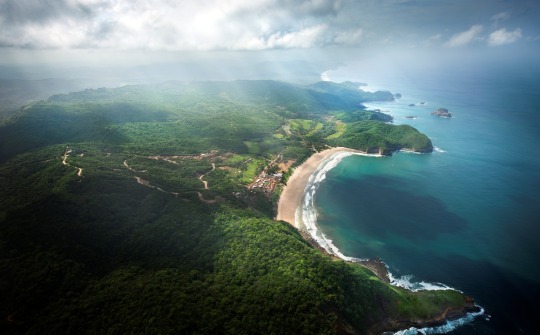
This Central American country, neighboring Honduras and Costa Rica, holds a number of titles, and you can add the largest lake in Central America to the list. With a view to both the Pacific Ocean and Caribbean Sea on opposite ends of the country, it’s no wonder Nicaragua means “here united with the water”. Imagine a nice walk down the beach, doesn’t it sound amazing?!
----------------------------The Culture----------------------------
The merging of different cultures within Nicaragua has caused the dawn of a creative, lively and blissful culture. Rhythmic marimbas and folkloric dances give vibrancy to fiestas across the country and the beautiful works of skilled artists spread an understanding of their history and nature.

The culture of Nicaragua reflects the mixed Ibero-European and Indian ancestry of the majority of its people. Diversity, I love it!
---------------------------The Weather---------------------------
Nicaragua has a tropical climate, hot all year round.
Temperatures are quite stable; however, there is a relatively cool winter from November to January, a hot spring from March to May, and a sultry and rainy summer from May to October. On the west coast, it's hot all year round, but there are the sea breezes. However, you may notice a certain temperature increase in the spring. On the Caribbean coast, there is no real dry month; owing to both the rains and the trade winds, the temperatures are a bit lower than on the west coast, but relative humidity is consistently high.
What’s a little rain to this magnificent view?
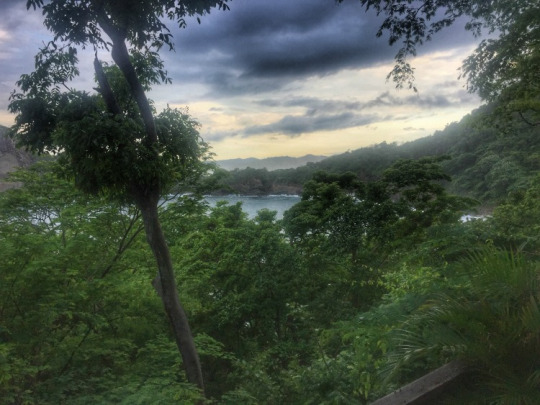
----------------------The Economic System-------------------
Nicaragua's economy is very active and has experienced great changes during the past decade or so. Its economy was truly a phoenix emerging from the ashes. The cause behind Nicaragua’s past economic problems stemmed from the earthquake of 1972 as well as the rule of the Sandinista regime. Nicaragua’s economic situation improved dramatically with the 1990 election of Violeta Chamorro and the establishment of a democracy. Nicaragua has a mixed economic system which includes a variety of private freedom, combined with centralized economic planning and government regulation.
Despite the expansive growth in Nicaragua’s economy that took place after the new form of government came in, Nicaragua remains one of the poorest countries in the region and faces issues such as unemployment, low per capita income and great foreign debt. Nicaragua’s economy is working towards improvement in the future, focusing on potential growth in the agricultural sector, energy generation, tourism, export manufacturing, mining and construction, as well as the sale of consumer goods.
With all this budding potential, Nicaragua is the perfect place to invest in, especially in the tourism aspect.
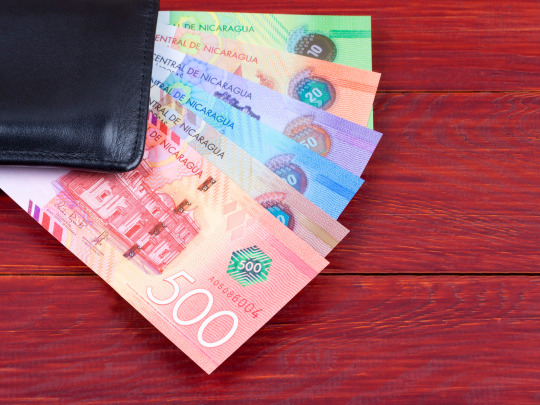
---------------Where to go & What to do---------------
Fun activities to do in Nicaragua include, but are not limited to: Eco-tourism; adventure and sports activities, including surfing, deep-sea fishing, swimming, snorkeling, kayaking, diving, volcano sand-boarding; historical and agricultural sites; cultural activities; agritourism; volunteerism; nightlife. Just enjoying the sun and all the different smells wile walking down the market would be wonderful. Nicaragua has lots to offer.

Towns like San Juan Del Sur on the Pacific Ocean's Emerald Coast near Costa Rica are top places to visit, famous for their colorful architecture and surf scene. Many things to do really lie in the smaller cities, like Leon and Granada, which are known for their colorful architecture and churches, and natural attractions such as Lake Nicaragua. It is the largest freshwater lake in Central America and home to hundreds upon hundreds of islands, including some with amazing ecolodges. Here are the Top 5 places to visit while exploring Nicaragua!
1. Islets of Granada
2. Corn Island
3. Masaya Volcano
4. El Cerro Negro
5. Mombacho Volcano Natural Preserve
---------------------------------------------------------------------------------------
SOUTH KOREA

South Korea is a country in Eastern Asia occupying the southern half of the Korean Peninsula. It borders the Sea of Japan, the Yellow Sea, and North Korea. In the year 1934, Korea was given the title "Chaohsien" which meant morning freshness. The title was well suited to South Korea because of its natural beauty of stunning mountains, clear waters and splendid peacefulness – particularly in the morning. Because of this, Korea was also called "Land of Morning Calm."
In a country filled with city lights and multitudes of people, a little calmness in the morning is just what you need to start the day out right!
------------------------The Culture-------------------------------
Korea is all about education, constantly ranked world-best in terms of education system and the knowledge of students as studies such as the PISA and the World Top 20 Poll suggests. They’re also quite unique when it comes to asking their age. In Korea, everyone is already one year old at birth. And not only that: on New Year’s, everyone simultaneously turns a year older! That means, in turn, that in Korean age, you could already be two years older than you are in an international age. In Korea, people love to have a good time and they also love entertainment. But they are not crossing the line—pun intended. Even in bustling Seoul, you will rarely see non-tourists jaywalking or misbehaving. It’s part of the identity and the culture to not cause too much trouble or problems for others.
The Korean entertainment industry is also becoming one of the biggest in the world. K-pop, k-movies, k-drama, k-beauty… the K’s all around! The catchy beats, colorful soap operas and gripping dramas are invading countries around the world with a massive force, and they are here to stay. No genre of media is excluded: Film, literature, graphic novels, language, food, fashion…you name it. But arguably the genre with the biggest global impact is the new wave of Korean pop music, commonly referred to as K-pop, with its addicting melodies and innovative choreographies. You know BTS?

----------------------------The Weather---------------------
South Korea has a temperate climate with four distinct seasons. Winter, from late November to mid-March, is freezing in the north and in the interior, while it’s milder, but still with night frosts, along the southern coast. Spring, from mid-March to May, is initially cool, and gradually becomes milder, but the rains become more frequent because of the formation of low pressure systems. Summer, from June to August, is hot, humid, and rainy. Autumn, from September to late November, is a pleasant season, especially in the month of October, when it’s not too cold or too hot.
Serious droughts occur about once every eight years. About two-thirds of the annual precipitation occurs between June and September. South Korea is less vulnerable to typhoons than neighboring countries. Typhoons usually pass over South Korea in late summer, especially in August and bring torrential rains.
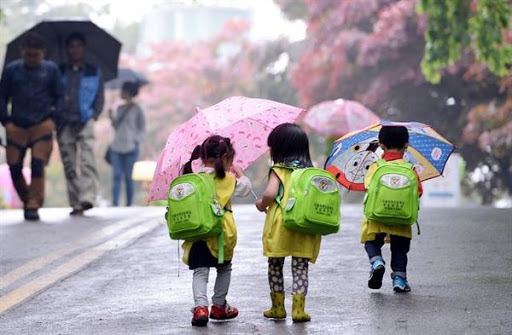
The weather may be crazy, but the sights are worth it, rain or shine!
-------------------The Economic System------------------
South Korea’s economy continues to maintain its ranking among the mostly free countries. It has a mixed economic system in which the economy includes a variety of private freedom, combined with centralized economic planning and government regulation. South Korea has achieved rapid growth in a short period. The country has displayed global competitiveness in various fields such as mobile phones, semiconductors, automobiles, chemicals, and steel making. In recent years, its cultural content, including music, gaming, and webtoons, is emerging as an essential industry in itself, taking the lead in the Korean economy.
South Korea's rigorous education system and the establishment of a highly motivated and educated populace is largely responsible for spurring the country's high technology boom and rapid economic development.
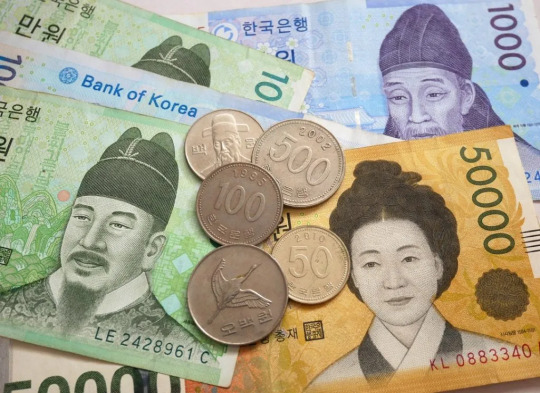
-------------------Where to go & What to do---------------
Travelers will want to indulge in all that South Korea has to offer like: Enjoy delicious Korean food, Explore Seoul on foot, Witness the grandeur of Changdeokgung and Gyeongbokgung Palaces, Learn about traditional Hanok architecture, Be a street artist, Check out free museums, Glide down the ski slopes from the 2018 Winter Olympics, Visit the temples, Take a trip to Busan, Experience a botanical garden island, and visiting Jeju-Si Island. The different architecture between residential places and the city alone is astonishing!

South Korea offers everything a traveler could want in a destination. It has a long and fascinating history, a wonderful culture, amazing food, friendly people, and an excellent tourism infrastructure. Here are the Top 5 places you must absolutely think back on when planning your trip:
1. Changdeokgung Palace
2. Gamecheon
3. Jeonju
4. Seoul Tower
5. Bukchon Hanok Village
-----------------------------------------------------------------------------------------
So Which One?
This may be a very biased answer, but being from Nicaragua, I’d say take an off-grid vacation. Although known for its tourism, you don’t loose the quiet peaceful atmosphere. Its rural landscape extends even to the most populated cities, adorning the country in a cloud of green and crystal blue waters everywhere you look. The gates are open, which life-thrilling destination will you choose?

2 notes
·
View notes
Text
The Bromacker Project Part VI: Seymouria sanjuanensis, the Tambach Lovers
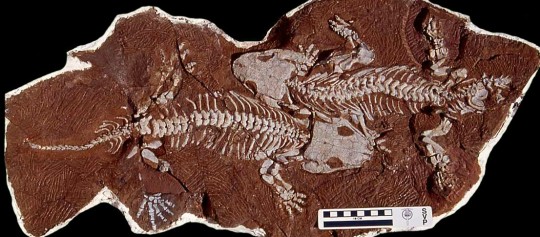
Two exquisitely preserved, nearly complete adult skeletons of Seymouria sanjuanensis that were discovered in the Bromacker quarry in 1997. Photo by Dave Berman.
At lunchtime on the last day of the 1997 field season, Thomas Martens discovered the two exquiste specimens shown above, the only fossils found that year. Thomas had uncovered a piece of the hip region with some attached vertebrae that resembled, once again, those of the ancient amphibian Seymouria. Because our work time was limited, we estimated the length of the specimen and rushed to extract it from the quarry. When we flipped the block over, a few pieces of rock fell out, revealing a series of vertebrae of a second individual in the block. We were thrilled to learn that Thomas had discovered two specimens of Seymouria. We put the rock pieces back in place and quickly finished plastering the block. There was just enough time for Dave, Stuart Sumida, and I to return to our hotel, clean up, quickly pack, and meet Thomas, his family, and his fossil preparator Georg Sommer for a celebratory dinner. What a great way to end the field season.
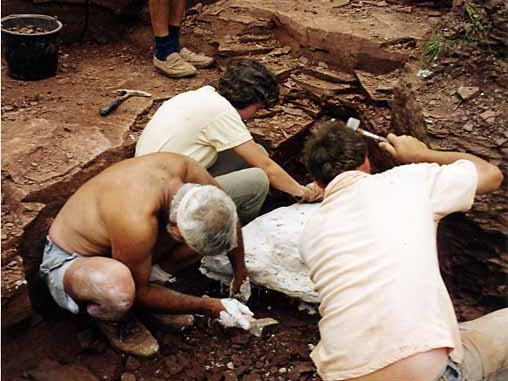
Working in tight quarters to quickly extract the Seymouria specimens discovered at lunchtime on the last day of the field season. Clockwise from right: Georg Sommer, Dave Berman, and the author. Photo by Stuart Sumida, 1997.
Seymouria had already been known from the Bromacker quarry. Thomas had discovered and identified two skulls in 1985, fossils he brought with him when he came to Carnegie Museum of Natural History (CMNH) in 1993 to study for six months with Dave Berman under a CMNH-financed fellowship. Both skulls were of juvenile individuals. Of the two known species of Seymouria, Dave and Thomas were excited to discover that the Bromacker skulls were nearly identical to those of Seymouria sanjuanensis. The 1997 lunchtime discovery of the two complete adult specimens confirmed the identification of the Bromacker Seymouria as S. sanjuanensis.
The first discovered species of Seymouria was Seymouria baylorensis, from near Seymour, Baylor County, Texas, from which its name was derived. Seymouria sanjuanensis was first found in San Juan County, Utah, by Dave Berman and the field team he was leading as a graduate student at the University of California, Los Angeles. Dave’s advisor, Dr. Peter Vaughn, named it Seymouria sanjuanensis in reference to the county of discovery. Another discovery of five specimens of this species preserved together was made by Dave in New Mexico in 1982.
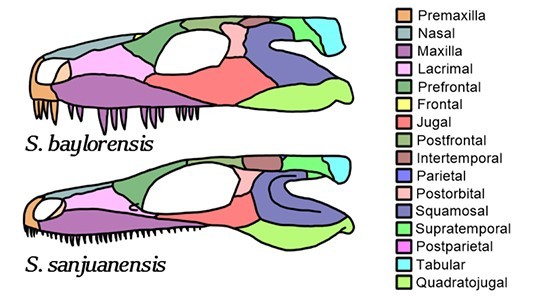
Comparison of the skulls of Seymouria baylorensis (top) and S. sanjuanensis (bottom). The individual bones of the skull are color coded. Skulls scaled to same size. Image from Wikimedia Commons.
Seymouria baylorensis is geologically younger than S. sanjuanensis and has a more robust skull, larger and fewer teeth of variable size, and a subrectangular postorbital bone compared to the chevron-shaped postorbital of S. sanjuanensis.
Seymouria is considered a terrestrial amphibian that only returned to water to breed. Its strongly built skeleton provided the support needed to move on land. With its numerous, slender, pointed teeth, S. sanjuanensis most likely ate insects and small land-living vertebrates. We know that the Bromacker Seymouria didn’t consume fish, because not a single fish fossil, scrap of fish fossil, or fish coprolite (fossil poop) has ever been found at the Bromacker quarry. Study of the rock deposits preserving the fossils at the Bromacker indicate a lack of permanent water, which would explain the absence of fish.
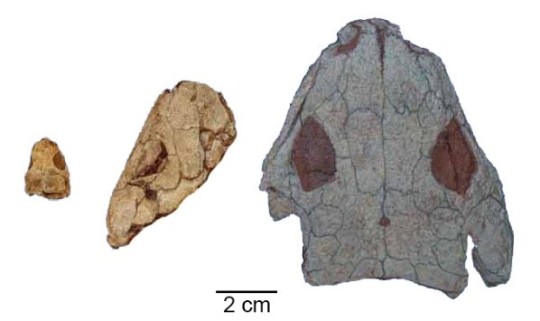
Growth series of skulls of Seymouria sanjuanensis from the Bromacker Quarry showing (left to right) early juvenile, late juvenile, and adult growth stages. Photos by the author, 2006.
Conditions for breeding must have been favorable in the Tambach Basin, the ancient basin where sediments preserving the Bromacker fossils accumulated, because several juvenile specimens of Seymouria are known. The smallest is a skull measuring about 3/4 of an inch long. In a study led by our colleague Josef Klembara (Comenius University, Slovak Republic), we determined that the smallest individual was post-metamorphic—in other words, no longer a tadpole—based on the presence of certain ossified bones in the skull. In tadpoles, these skull elements are cartilaginous; that is, they haven’t yet turned to bone.
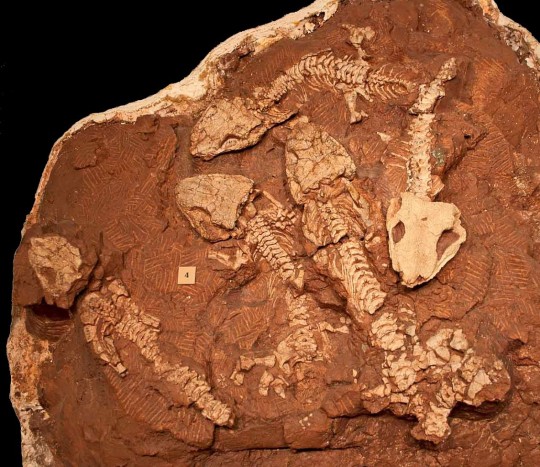
Five skeletons of Seymouria sanjuanensis preserved together were discovered in north central New Mexico by Dave Berman in 1982. These specimens are on display in CMNH’s Benedum Hall of Geology, in the “What is a Fossil?” case. Photo by the author, 2013.
The discovery in Germany of the same species of Seymouria previously known only from New Mexico and Utah has important implications in terms of paleobiogeography (the study of the distribution of species in space and time). At the time S. sanjuanensis was alive, the continents were merged to form the supercontinent Pangaea. The presence of S. sanjuanensis across Pangaea, north of a roughly east-west trending mountain range, indicates that climatic or physical barriers (e.g., deserts, inland seas, mountain ranges) didn’t prevent its dispersal.
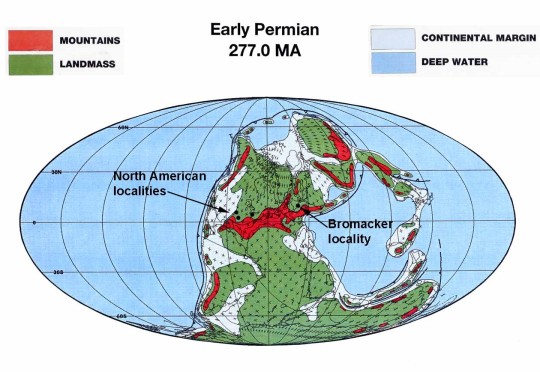
Map showing the arrangements of the continents in the Early Permian. The locality where Seymouria occurs in present-day New Mexico, Texas, and Utah and the Bromacker locality in present-day Germany are indicated. Map modified from Scotese, 1987.
The two Seymouria specimens preserved together were a big hit in the local region in Germany. Museum der Natur (MNG) exhibit preparator Peter Mildner nicknamed them the “Tambacher Liebespaar” (“Tambach Lovers”) after a painting entitled “Gothaer Liebespaar” (“Gotha Lovers”) on exhibit in the Herzogliches Museum of the Stiftung Schloss Friedenstein (also the parent organization of MNG). This name caught on and is fondly used by our German friends and colleagues. Peter even made a fleshed-out model of the two Seymouria specimens in their death pose. The proprietor of the hotel in which we stayed hung a copy of the model of the Tambach Lovers and a framed collage of newspaper articles featuring the Bromacker on a wall in one of the hotel rooms, which she named the “Präparation Suite” (i.e. “Preparation Suite” in reference to the preparation of fossils). I often stayed in this room.
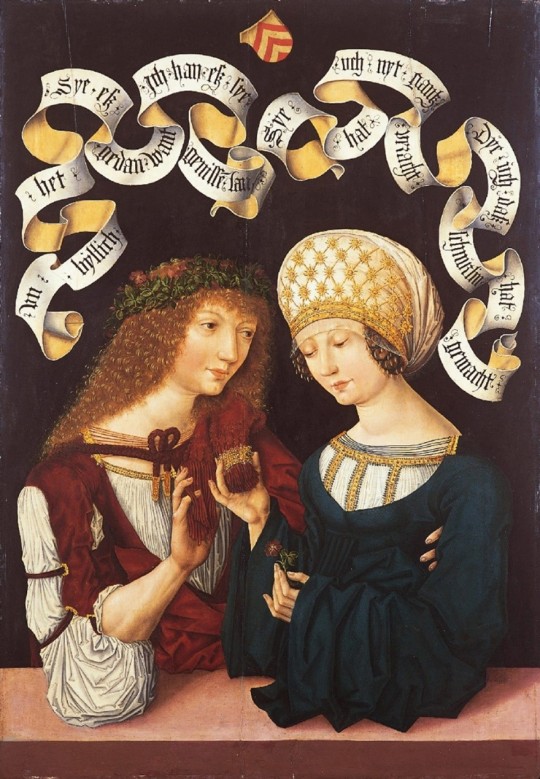
The painting entitled “Gothaer Liebespaar” (“Gotha Lovers”), which is on display at Herzogliches Museum of the Stiftung Schloss Friedenstein, Gotha, Germany. Image from Wikimedia Commons and provided by Thomas Martens.
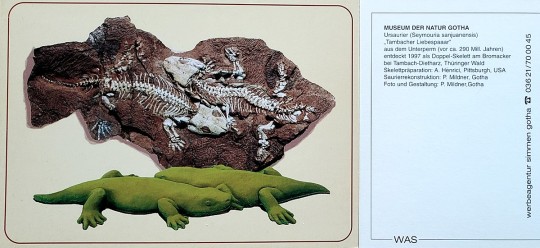
Postcard showing the Tambach Lovers. The postcard was made for and sold by the Museum der Natur, Gotha. Photo of the postcard by the author, 2020.
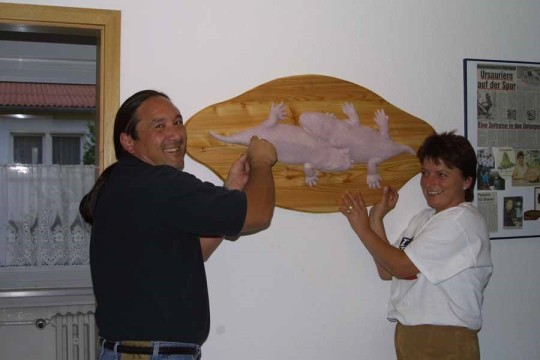
Stuart Sumida (left) and Heike Scheffel, proprietor of the Hotel Wanderslaben where we stayed (right), with the model of the Tambach Lovers in the “Präparation Suite.” The framed collage to the right of the model holds newspaper articles featuring the Bromacker project. Photo by the author, 2003.
A cast of the Tambach Lovers specimen and a model of Seymouria sanjuanensis are exhibited in the Fossil Frontiers display case in CMNH’s Dinosaurs in Their Time exhibition. Be sure to look for them once the museum re-opens. And stay tuned for my next post, which will feature the unusual bipedal reptile Eudibamus cursoris.
For those of you who would like to learn more about Seymouria sanjuanensis, here is a link to the publication describing the 1997 specimens: https://www.tandfonline.com/doi/abs/10.1671/0272-4634(2000)020%5B0253%3AROSSSF%5D2.0.CO%3B2.
Amy Henrici is Collection Manager in the Section of Vertebrate Paleontology at Carnegie Museum of Natural History. Museum employees are encouraged to blog about their unique experiences and knowledge gained from working at the museum.
#Carnegie Museum of Natural History#Bromacker Quarry#Seymouria sanjuanensis#Fossils#Paleontology#Vertebrate Paleontology
34 notes
·
View notes
Video
Lake Fork of the Gunnison Flowing Through the San Juan Mountains by Mark Stevens Via Flickr: A view looking from an overlook to the north from a roadside pull off along Colorado Highway 149 just south of Powderhorn.
#Azimuth 354#Blue Skies#Colorado Great Sand Dunes & Black Canyon of the Gunnison#Colorado State Highway 149#Day 3#DxO PhotoLab 3 Edited#East-Central San Juan Mountains#Forest#Forest Landscape#Hillside of Trees#Lake Fork of the Gunnison#Landscape#Landscape - Scenery#Looking North#Mountain Peak#Mountains#Mountains in Distance#Mountains off in Distance#Mountainside#Nature#Nikon D850#No People#Outside#Project365#Ridge#Ridgeline#Ridges#River#Roadside Pulloff#Rocky Mountains
2 notes
·
View notes
Text
Architecture of 2020: Buildings of the Year
Architecture in 2020, Buildings of the Year, Architects, Major Property Designs, Photos
Architecture of 2020: New Buildings
e-architect Selection of Key Contemporary Architectural Developments
post updated 13 May 2021 ; post updated 1 Jan 2021 ; 20 + 19 + 18 Dec 2020
Major Architecture of 2020
The winner is clearly REE Campus, Madrid, Spain, polling a massive 37.46%, with a total of 481 votes
REE Campus, Madrid, Spain Architects: IDOM photo : Aitor Ortiz REE Campus in Madrid
In second place is the Loop of Wisdom, Chengdu, China, with 28.58% of the total vote, and 367 votes
Loop of Wisdom, Chengdu, south west China Architects: Powerhouse Company photo : Jonathan Leijonhufvud Architectural Photography Loop of Wisdom Museum in Chengdu
In third place is Cosmote TV HQ and Studios, Athens, Greece, with 25.23% of the vote and 324 votes.
Cosmote TV HQ and Studios, Athens, Greece Design: LC Architects photo © Nikos Daniilidis Cosmote TV HQ and Studios in Athens
Happy New Year to our readers!
e-architect have selected some key buildings of 2020.
Our parameters? Architecture designs that stimulate, buildings that ask significant questions, designs that show creativity and innovation.
We have considered the year’s international architecture highlights to pick out the key buildings of the year. We are deliberately not considering the complex task of selecting ‘winners’.
(Adrian Welch, e-architect editor)
We are focusing this year only on completed buildings, not building designs (ie unbuilt proposals).
Buildings / designs are listed in georgaphical order, per our folder structure.
We are still adding projects today, this list wll be finalised over the weekend!
********************
A further selection of buildings around the world – shortlisted but not in the final cut:
Buildings of 2020
********************
Yes, you can now vote on your favourite project:
Architecture of 2020 – which is best?
Major Buildings completed in 2020
Architecture in 2020 – latest additions to this page, arranged chronologically:
AMERICA – USA
False Bay Writer’s Cabin, San Juan Islands, Washington Architects: Olson Kundig photo : Tim Bies / Olson Kundig False Bay Writer’s Cabin, San Juan Island This five-hundred-square-foot cabin serves as a private writer’s retreat and guest cottage. The owners of False Bay Writer’s Cabin asked for a space that felt connected to its island setting—the mild climate, scenic views, and proximity to wildlife. At the same time, they needed a structure that could be easily secured when not in use.
Red Rocks Residence, Camelback Mountain, Phoenix, Arizona Architect: The Ranch Mine photograph : Roehner + Ryan Red Rocks Residence in Phoenix, Arizona Clinging to the side of Camelback Mountain in Phoenix, Arizona, a Spanish Colonial Revival style house has been transformed into a modern dwelling that creates and elevates a variety of experiences with both the natural and man-made environment.
LR2 Residence, Pasadena, California Design: Montalba Architects photography : Kevin Scott LR2 Residence in Pasadena, California The modern American esidence overlooks Pasadena and its adjacent mountains from its hillside perch. This new 4,200-sqft house is made up of several distinct living volumes and programs.
AMSTERDAM
Diamond Exchange, Amsterdam, The Netherlands Design: ZJA photo © Capital C Amsterdam Diamond Exchange, Capital C Amsterdam The Diamond Exchange, Capital C Amsterdam in Amsterdam, the Netherlands, has been awarded with a prestigious MIPIM Award 2020 for ‘Best Refurbished Building’ at the Paris Real Estate Week. The historical building, designated as a national monument, has undergone a major renovation designed by the architectural office ZJA in collaboration with Heyligers design + projects.
ATHENS
Cosmote TV HQ and Studios, Athens, Greece Design: LC Architects photo © Nikos Daniilidis Cosmote TV HQ and Studios Designed by London-based architecture and design practice LC Architects, Cosmote TV HQ and Studios is a new, innovative building inspired by contemporary media and the constant flow of information.
BANGKOK
Power Wing, Bangkok, Thailand Design: Openbox Group and Openbox Architects photo : Panoramic Studio Car Parking Solar Roof Bangkok After many success OPENBOX design interventions for large scale projects, B. Grimm Power send us a brief to help creating an awareness of the important of sustainable energy to public. The brief was to create an iconic piece of landmark at their Headquarters Office, that can send a strong message.
BEIJING
Courtyard Kindergarten, Beijing Design: MAD Architects photo © ArchExist Courtyard Kindergarten by MAD Architects A kindergarten sited next to a senior citizens’ apartment, reflecting the client’s “intergenerational integration” ethos that blends pre-school education and elder care. The 9,275 sqm site consists of an 18th century Siheyuan courtyard, an adjacent replica courtyard built in the 1990s, and a four-story modern building.
Beijing Zhongshuge Lafayette store interior, Beijing Architects: X+LIVING photo : Wu Qingshan Beijing Zhongshuge Lafayette store design It’s the second time for Zhongshuge bookstore to land in Beijing. This time it joins Lafayette department store, where the classical gardens and the reading space collided from three different perspectives in the fashionable commercial area.
CANADA
New Central Library, Alberta Architects: Snøhetta and DIALOG photography © Michael Grimm New Central Library in Calgary Calgary’s New Central Library aims to welcome over twice as many as previously annual visitors to its 240,000 SF of expanded facilities, the library will fill a vital role for the rapidly expanding city. As Calgary’s largest public investment since the 1988 Olympics, the library signals the beginning of a new chapter in the life of the city, one centered on the creation and innovation of knowledge and culture.
CHINA
Yabuli Entrepreneurs’ Congress Center, North east China Design: MAD Architects photo © ArchExist Yabuli Entrepreneurs’ Congress Center Nestled in the snow-covered mountains of Northeastern China, the project was commissioned by the Yabuli China Entrepreneurs Forum (Yabuli CEF), one of China’s most influential business organizations. November 18th to 20th saw the venue’s opening ceremony and its first event, the Yabuli CEF’s 20th annual conference, attended by over 600 entrepreneurs.
Regeneration – Free Spring Morning, Suzhou, China Design: LACIME Architects photo © SHANJIAN Photography Studio Free Spring Morning, Suzhou Building As rational consumerism prevails, the traditional real estate design model of spending a lot of money to build a luxury sales office is fading away. The sales office is one of the most important design elements in real estate design, and this element is now going to two extremes – permanent sales offices are paying more attention to the pursuit of high quality, and temporary sales offices are increasingly looking for rapid efficiency.
Yingliang Stone Natural History Museum, Fujian, South East China Design: Atelier Alter Architects photograph : Atelier Alter Architects Yingliang Stone Natural History Museum, Fujian Over the years of stone mining, the manufacture has discovered numerous fossils. The manufacture decides to dedicate the headquarter building to a museum to tell the history of the fossils and the natural science of researching the fossil. There are two major challenges during the renovation process.
OCT Chuzhou Minghu Experience Center, Chuzhou, Anhui Province Design: Lacime Architects photograph : Schran Images OCT Chuzhou Minghu Experience Center The project site is located in the Minghu Lake area, the southeastern part of the planned new town of Chuzhou city, Anhui Province. It is adjacent to Chuzhou-Yangzhou Expressway and the Beijing-Shanghai High-speed Railway, surrounded with a favorable landscape environment.
Changzhou Culture Center Architect: gmp · von Gerkan, Marg and Partners · Architects photography © Schran Images Changzhou Culture Center Building In the Chinese province of Jiangsu, within the catchment area of Shanghai, lies the city of Changzhou which, with its about 5 million inhabitants, has developed into an important industrial metropolis in the Yangtze Delta region. In the newly created city center of Changzhou, the architects von Gerkan, Marg and Partners (gmp) have created a cultural center with an art museum, library, hotel, offices, and retail areas.
SigMann Showroom, Guangzhou Architects: Spring Design Office image : b+m studio/ Kelvin SigMann Showroom Guangzhou SigMann is a cabinet and home furnishings brand, the name of which is derived from “Sig” and “Manna”. “Sig” is the abbreviation of “special interest group”, which represents cultivated, decent and tasteful elites, while “Manna” comes from Bible and implies food for thought.
Longfu Life Experience Center, Puyang County, Henan Province, China Design: LUO studio photo : Jin Weiqi Longfu Life Experience Center Real estate sales center is a kind of temporary architecture that can only last several months or few years at most, which is usually dismantled after houses are sold out. Even if it can be preserved in few cases, functions are completely transformed.
Loop of Wisdom, Chengdu, south west China Architects: Powerhouse Company photo : Jonathan Leijonhufvud Architectural Photography Loop of Wisdom Museum, Chengdu Living up to the suggestiveness of its name, the Loop of Wisdom embodies a timeless architectural concept. Powerhouse Company’s design for a technology museum and reception center for a new neighborhood in Chengdu, China, is much more than an exuberant landmark.
Imperial Kiln Museum, Jingdezhen, Jiangxi Architects: Studio Zhu-Pei photography : schranimage, Tian Fangfang, Zhang Qinquan, courtesy of Studio Zhu-Pei Jingdezhen Imperial Kiln Museum, Jiangxi Located in the center of the historical area, the site of the Imperial Kiln Museum is adjacent to the Imperial Kiln ruins surrounding many ancient kiln complexes. Jingdezhen is known as the “Porcelain Capital” in the world because it has been producing pottery for 1,700 years.
Pingshan Performing Arts Center, Shenzhen, south east China Design: OPEN Architecture photo © Zeng Tianpei Pingshan Performing Arts Center, Shenzhen In tandem with China’s economic boom and rapid urbanization, theaters have sprung up throughout the country in the past decade. Most have extravagant exteriors, but are often spatially monotonous and far detached from the general public and everyday urban life, greatly underutilizing the tremendous public resources invested in them.
Yifang Art Center, Chongqing, south west China Design: YIHE Landscape Architecture photo : Arch-Exist Yifang Art Center in Yubei District, Chongqing The Yifang Art Center project is in a newly developed Dazhulin district in the north of Chongqing downtown. When YIHE Landscape Architecture first visited the site, it had an unfinished concrete structure from previous development.
Kaihua County 1101 Project and Urban Archives, Kaihua County, Zhangzhou City, Zhejiang Province, China Design: The Architectural Design & Research Institute of Zhejiang University Co., Ltd photo © Zhou Yifan Kaihua County 1101 Project and Urban Archives This bold Chinese architectural project was commissioned by Kaihua County Urban Construction and Development Co., Ltd. to design a comprehensive office building with three functional requirements: the Urban Archives and the Civil Defense Command Center and the Housing and Construction Bureau at the entrance of the scenic spot. The project has a superior geographical position.
Chinese University of Hong Kong, Shenzhen Architects: Rocco Design Architects Associates image courtesy of architects office Chinese University of Hong Kong Campus Shenzhen The CUHK SZ brings the global perspective and academic excellence to the city Shenzhen – China’s rapidly-growing innovation and tech hub.
White Square, G54 exhibition center, Nanjing Design: MINGGU DESIGN photograph : Xia Zhi White Square, G54 exhibition center White Square, located at No.99 Yunxi road, the central area of Nanjing airport city. With the construction development of new airport city, a vast comparative maturity residential area has been built.
Gongshu Intelligence Valley’s Eye, Hangzhou, Zhejiang Interior design: E+LAB photograph : Schran Images – Su shengliang Gongshu Intelligence Valley’s Eye Hangzhou The Eye of Intelligence Valley is the exhibition center in the intelligence valley town in Hangzhou. It is a multi-functional public building for culture display, investment attraction, office meeting, recreation and etc. The design philosophy starts with the geometric relation of ‘round sky and square earth’.
Sunac · Grand Milestone Modern Art Center, Xi’an City Interior design: Cheng Chung Design (HK) photo © Qilin Zhang Sunac · Grand Milestone Modern Art Center in Xi’an Erecting in the magnificent ancient capital Xi’an with a modern and stylish gesture, Sunac · Grand Milestone Modern Art Center appears like a large crystal “gift box”, which brings amazing fashionable touches to the land featuring a long history and profound culture. It aims to become a city landmark, and to lead the trend of the era.
Shou County Culture and Art Center, Anhui Architects: Studio Zhu-Pei photograph : Schran Images Shou County Culture and Art Center Shou County is located in the center of Anhui Province, on the south bank of Huai River. In ancient times, it was the home of the Chu culture and where Liu An, King of Huainan, edited a compendium of ancient Chinese philosophy and composed poetry.
National Maritime Museum, Tianjin, north east China Design: Cox Architecture photograph : Terrence Zhang National Maritime Museum of China in Tianjin Major new cultural landmark for China takes its place on the Global stage China’s first National Maritime Museum has now commenced formal operation, the culmination of a 6-year process which began with an international design competition, followed by an intensive design and construction process.
COSTA RICA
Santiago Hills Villa Santa Teresa, Costa Rica Architects: Studio Saxe photograph : Andres Garcia Lachner Santiago Hills Villa in Santa Teresa This stunning wing-like roofline houses a dramatic white villa in the Costa Rica jungle.
DUBAI
The Opus, Dubai, UAE Design: Zaha Hadid Architects photograph : Laurian Ghinitoiu The Opus Hotel in Dubai Home to the new ME Dubai hotel, The Opus is located in the Burj Khalifa district adjacent to Downtown Dubai and Business Bay on the Dubai Water Canal.
FRANCE
Belaroia Hotel and Apartments, Montpellier, France Design: Manuelle Gautrand Architecture photo © Luc Boegly Belaroia Hotel and Apartments in Montpellier Belaroia Hotel and Apartments is an important project for the City of Montpellier and its development agency, the SERM, as it holds a strategic position between the city’s hyper-centre, characterised by its escutcheon form in plan, and new surrounding districts that have appeared in succession.
MEETT Exhibition and Convention Centre, Toulouse, southern France Design: OMA photograph : Marco Cappelletti, Courtesy of OMA MEETT Exhibition and Convention Centre MEETT, Toulouse’s new Exhibition and Convention Centre designed by OMA / Chris van Duijn, has been completed, becoming the third largest parc des expositions in France outside of Paris.The 155,000 sqm project incorporates exhibition halls, a convention centre, a multi-function event hall, a car park silo for 3,000 cars and a transportation hub with a new tram station.
GREECE
Two Summer Houses in Andros, northern Greek Cyclades archipelago Design: Praxitelis Kondylis Architects image from architecture office Summer Houses in Andros Nestled among Andros’ wild mountains, fecund valleys and waterfalls, this complex consists of two detached houses covering around 600m2 in land of 9200m2. Modern and rigorous, the design bears clear lines and is organically linked to the natural landscape of Andros.
KOREA, REPUBLIC OF
Hankook Technoplex, Pangyo, outskirts of Seoul Design: Foster + Partners photo : TIME OF BLUE Hankook Technoplex in Pangyo The new building embraces several themes that are symbolic of Hankook’s desire to create a dynamic office environment that supports flexible working styles, as the company looks towards the future.
Galleria Department Store, Gwanggyo Design: OMA Photography by Hong Sung Jun, courtesy of OMA Galleria Department Store in Gwanggyo The Galleria is Korea’s first and largest upscale department store franchise founded in the 1970s, and has remained at the forefront of the premium retail market in the country since then.
MADRID
REE Campus, Madrid, Spain Architects: IDOM photo : Aitor Ortiz REE Campus Red Eléctrica de España has commissioned IDOM for the comprehensive rehabilitation of two buildings in the Tres Cantos Technology Park (Madrid). The action includes a comprehensive adaptation to the new training and technological needs of the company, modernizing the set of buildings through an envelope that enables compliance with energy efficiency requirements.
MANCHESTER
The Oglesby Centre, Manchester, England, UK Architects: Stephenson Studio photos : Daniel Hopkinson Architectural Photography Extension to Hallé St. Peter’s, Ancoats The new extension, The Oglesby Centre, is conceived as a classically proportioned modernist metaphor of the existing proportions of St Peter’s massing.
MEXICO
Solaz Los Cabos Hotel, San José del Cabo, Baja California Sur, Mexico Design: Sordo Madaleno Arquitectos photograph : Rafael Gamo Solaz Los Cabos Hotel in San José del Cabo The extraordinary natural surroundings of the peninsula of Baja California with its semi-desert landscape provides an ideal selected context for the construction of a new landmark hotel for the country.
MILAN
MEET Digital Arts Center, Milan, Italy Design: CRA-Carlo Ratti Associati and Italo Rota photograph : Michele Nastasi MEET Digital Arts Center CRA-Carlo Ratti Associati and Italo Rota unveil MEET – Milan’s center for digital culture and creative technology. Occupying a newly renovated historic palazzo, the building revolves around a 15-meter-high vertical plaza. The design investigates how physical space can foster serendipity and unexpected connections between people in a digital world. MEET will open to the public on October 31st, 2020.
MONTREAL
Caffettiera Caffé Bar, Montréal, Québec, Canada Design: Ménard Dworkind Architecture & Design – MRDK photo © David Dworkind Caffettiera Montréal Caffé Bar In Italy, going to the coffee bar is not just about the coffee. It’s about taking a break from the day, meeting up with friends or taking the time to contemplate life. Caffettiera Caffé Bar aims to bring that culture to North America at its 745-square-foot commercial space in the heart of downtown Montreal.
MOSCOW
n.n. – Residence, beside the River Moskva near Moscow, Russia Design: J. MAYER H. und Partner, Architekten mbB, with Alexander Erman architecture & design photo : Ilya Ivanov n.n. – Residence near Moscow n.n. represents a spatial exploration between concealment and exposure. This layered topography blurs the line separating landscape and construction. It is the private residence of a family in a rural area along the River Moskva.
NEW YORK
111 West 57th Street, Manhattan, NYC Design: ShoP Architects photograph courtesy of 111 West 57th Street A design tour de force embraces the classic New York skyscraper and artisan tradition and thoughtfully restores the cultural landmark Steinway Hall. A bold yet graceful residential tower that soars perfectly centered over Central Park in Midtown Manhattan.
PARIS
Public Condenser, Ile-de-France, France Design: Muoto Architects photograph : Maxime Delvaux Public Condenser in Gif-sur-Yvette, Paris-Saclay The project is a public facility, situated on the new campus of Paris-Saclay. The building hosts a mix of activities including indoor and outdoor sports facilities, a restaurant, cafeteria, and various public spaces: a pedestrian square, street terraces, park areas for deliveries, bikes and cars.
PERTH, AUSTRALIA
North Perth House, Perth, Western Australia Design: Architect Nic Brunsdon photo : Ben Hosking North Perth House The North Perth House is an urban-infill project in inner-city Perth. Located on a small block, the design responds by providing a variety of spaces, determined by a simple structural arrangement.
PRAGUE
Five, Smíchov, Prague, Czech Republic Design: QARTA ARCHITEKTURA photo : BoysPlayNice Five Smíchov “History meets future”, declares the fitting motto chosen for the project Five, located in Prague 5 – Smíchov. A tram depot building occupied the project site, but that could have been called a relic even when it was built. While forming an important endpoint in the city transport system, complicated access had been its disadvantage right from the beginning.
QATAR
Doha Metro Network, Doha, Qatar Architects: UNStudio Interior Msheireb (interchange) Station. photo © Hufton+Crow Doha Metro Network Stations With the Doha Metro, Qatar Railways has created one of the most advanced and fastest driverless metro systems in the world. Phase one of the project involved the construction of three metro lines (Red, Green and Gold), with 37 stations currently having been completed.
ROTTERDAM
Depot Boijmans Van Beuningen, Rotterdam, The Netherlands Design: MVRDV, architects Aerial photograph of Depot Boijmans Van Beuningen © Ossip van Duivenbode Museum Boijmans Van Beuningen Depot Boijmans Van Beuningen, the first publicly accessible art depot in the world designed by MVRDV, has completed construction. Located in Rotterdam’s Museumpark, the depot features a new type of experience for museum visitors: a sturdy engine room where the complete collection of 151,000 objects is made accessible to the public.
SAUDI ARABIA
KAPSARC, Riyadh, Saudi Arabia Design: Zaha Hadid Architects – ZHA photo : Hufton+Crow King Abdullah Petroleum Studies & Research Centre King Abdullah Petroleum Studies and Research Centre is a non-profit institution for independent research into policies that contribute to the most effective use of energy to provide social wellbeing across the globe. The 70,000 sqm KAPSARC campus incorporates five buildings.
King Fahad National Library, Riyadh, Saudi Arabia Design: Professor Eckhard Gerber – Gerber Architekten photograph : Christian Richter King Fahad National Library Riyadh The King Fahad National Library, one of the most important cultural buildings in the Kingdom of Saudi Arabia, was completed and went into use for its intended purpose in 2015. This project sees Professor Eckhard Gerber and his Gerber Architekten team accomplishing one of the most important urban development and cultural projects in the capital, Riyadh.
SHANGHAI
Suzhou Financial Center Exhibition Hall, Shanghai, China Architects: Shanghai Riqing Architectural Design Co., Ltd. photograph : Schran Images Suzhou Financial Center Exhibition Hall This architectural project is located in the central section next to Suzhou Canal, where there is a grand canal view in the distance and urban trunk road in close proximity. The architects explore inherent logic of local cultural form and language and apply them to the design to stimulate the vitality of surrounding open space and make it the city parlor for residents.
Ports 1961, Shanghai, China Architects: UUfie photo : Shengliang Su Ports 1961 Flagship Store Located at a major high-end commercial district at the intersection of Changde Road and Nanjing West Road, a new façade is created for the flagship store of fashion house Ports 1961.
SINGAPORE
Apple Marina Bay Sands, Singapore Design: Foster + Partners photo : Finbarr Fallon Apple Marina Bay Sands A new distinctive 30-metre-diameter structure is a fully glazed dome with a black glass base, complementing the sister pavilions through its scale and materiality.
SPAIN
House Of The Sun, Marbella, Costa del Sol, Andalucia, Southern Spain Design: Fran Silvestre Arquitectos image from Fran Silvestre Arquitectos House Of The Sun in Marbella Fran Silvestre Arquitectos have always been fascinated by the work of Andreu Alfaro “The door of the Universe” made in 1983. A circle rotated and suspended over a square.
House Of The Silence, Valencia, eastern Spain Design: Fran Silvestre Arquitectos photo : Fernando Guerra, FG + SG House Of The Silence, Valencia The House Of The Silence project consists of making a musician’s studio coexist with his home. It is located in a residential area near Valencia, where neighboring houses are very close to each other.
SWITZERLAND
Kunsthaus Zürich, Switzerland Design: David Chipperfield Architects Berlin photograph : Noshe Kunsthaus Zürich Building After twelve years of planning and construction, the extension for the Kunsthaus Zürich is now complete. On 11 December 2020, the keys to the new building were handed over to its future user in an online ceremony. The house will open to the public in October 2021.
SYDNEY
The Waterfront Retreat, Newport, New South Wales, Australia Architecture: Koichi Takada Architects photo : Tom Ferguson Photography The Waterfront Retreat Newport, NSW The Waterfront Retreat is the epitome of an Australian dream home, adorned with a private beach, garden and open-plan living. Responding the clients’ brief – a house offering sanctuary and entertainment, the Waterfront Retreat is designed to allow nature to lead, offering maximum seclusion and connection to its surrounds and outlook.
THAILAND
Apple Central World, Bangkok, Thailand Design: Foster + Partners with Architects 49 Ltd. photograph © Apple Apple Central World Bangkok Apple Central World in Bangkok welcomed its first visitors. Located in one of the city’s iconic urban centers, the new store establishes a quiet sculptural presence at the heart of the bustling Central World Square on the intersection of Rama I and Ratchadamri roads.
TAIWAN
Lè Architecture, Taipei, Taiwan Architects: Aedas photo courtesy of architects Lè Architecture in Taipei Designed by Global Design Principal Dr Andy Wen, Lè Architecture in the Nangang district of Taipei redefines Taipei’s rapidly developing skyline. Its design drew inspiration from the shape of the river pebbles along the Keelung River, developing a unique aesthetic concept that conveys the idea of roundness and elegance, as well as strength and character.
VIETNAM
EcoKid Kindergarten, Vinh, near Hanoi, Vietnam Architects: LAVA with Module K and Viet Décor photo : Hiroyuki Oki EcoKid Kindergarten Vinh, Vietnam The design of a new eco-kindergarten by LAVA with Module K and Viet Décor features spaces encouraging curiosity, activity-based learning and interaction with nature for the next generation of Vietnamese children.
********************
Vote please! Vote
********************
A further selection of buildings around the world:
Buildings of 2020
Architecture Awards
Contemporary Architectural Awards – selection:
RIBA Awards
Stirling Prize
RIBA Royal Gold Medal
Key Architects Links
Zaha Hadid
Frank Gehry
Herzog de Meuron
Key Architectural Links
American Architecture
Contemporary Architecture
Modern Houses
Buildings of the Year Archive
Architecture of 2013: Buildings of the Year
Building Designs of 2013
Architecture of 2012: Buildings of the Year
Architecture of 2011
Comments / photos for the Architecture of 2020 page welcome
Website: Building
The post Architecture of 2020: Buildings of the Year appeared first on e-architect.
1 note
·
View note